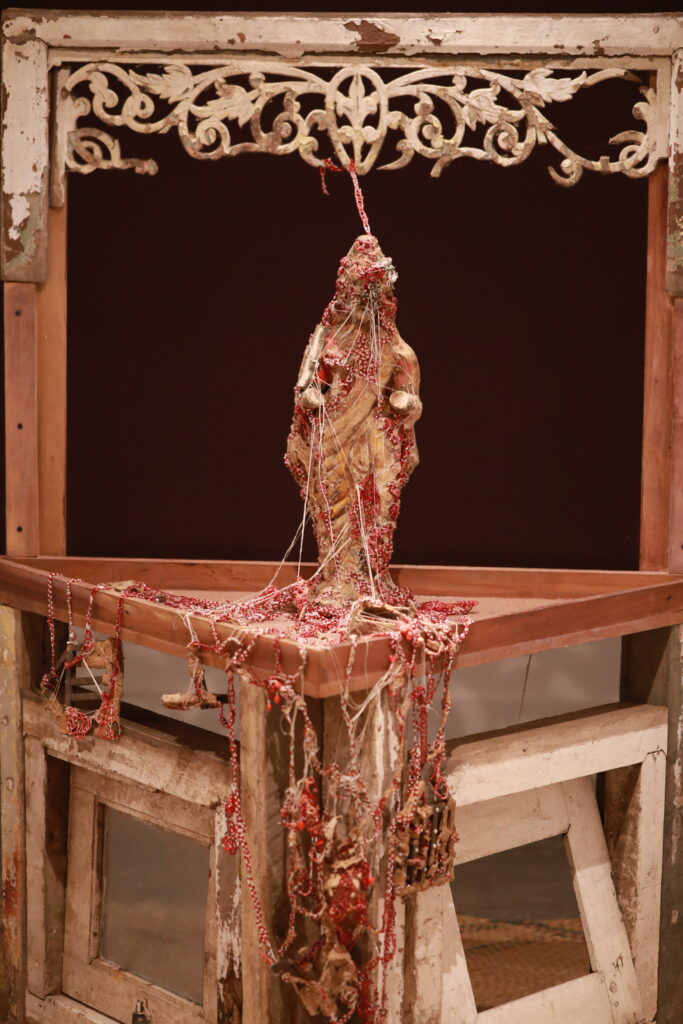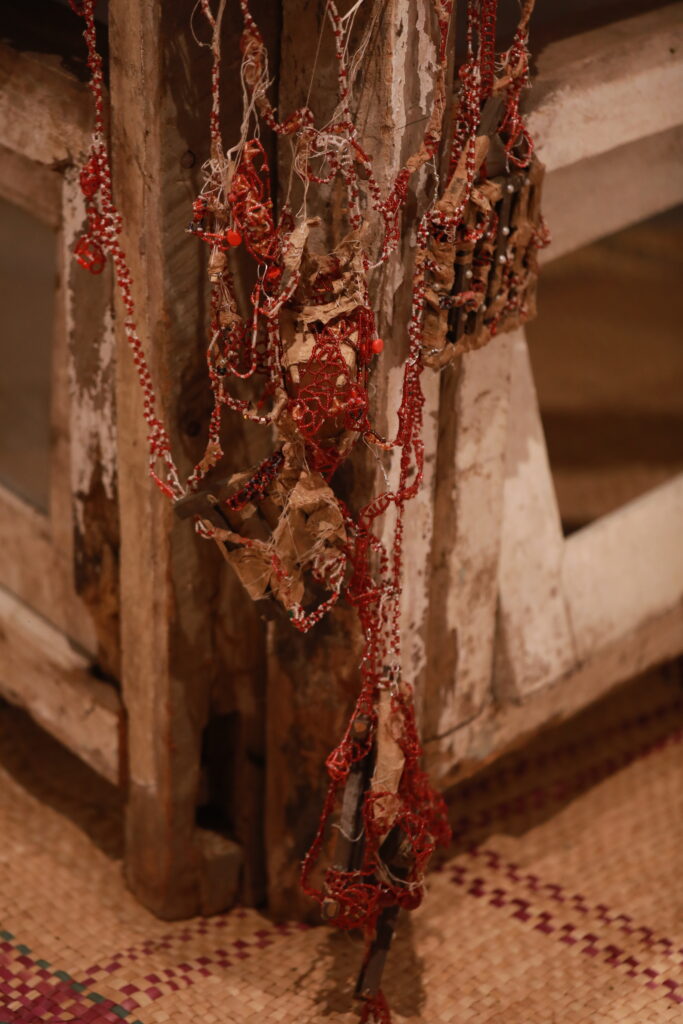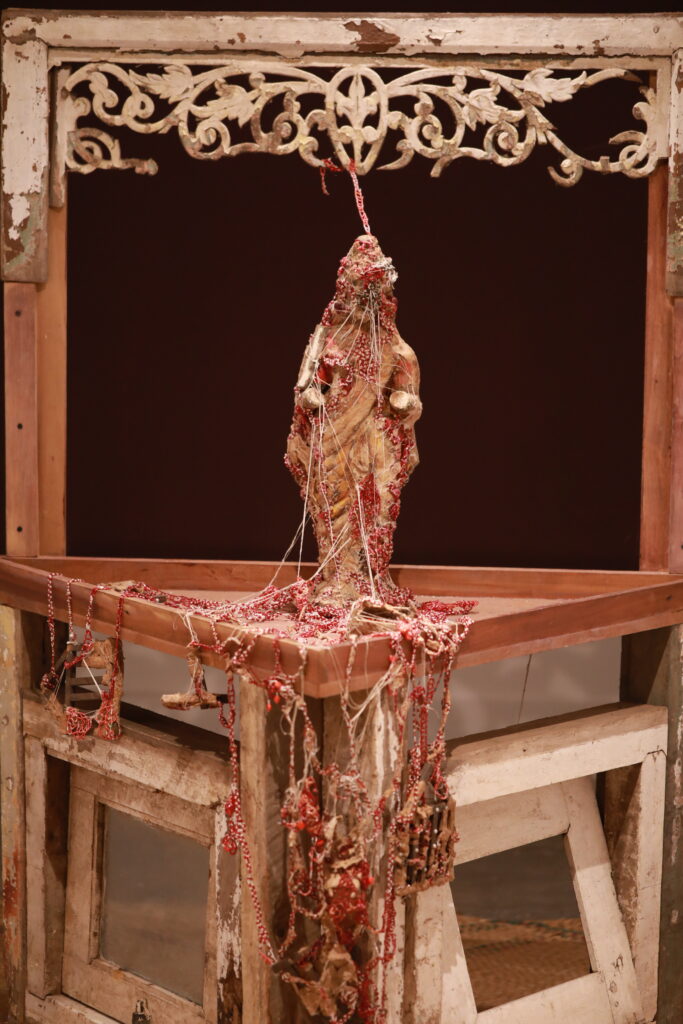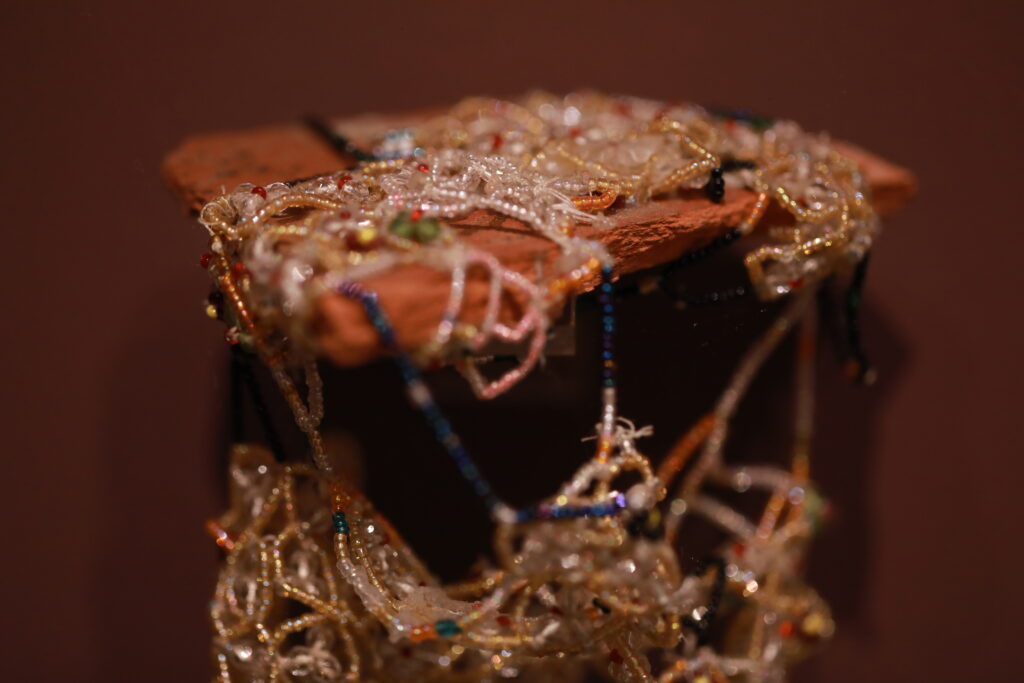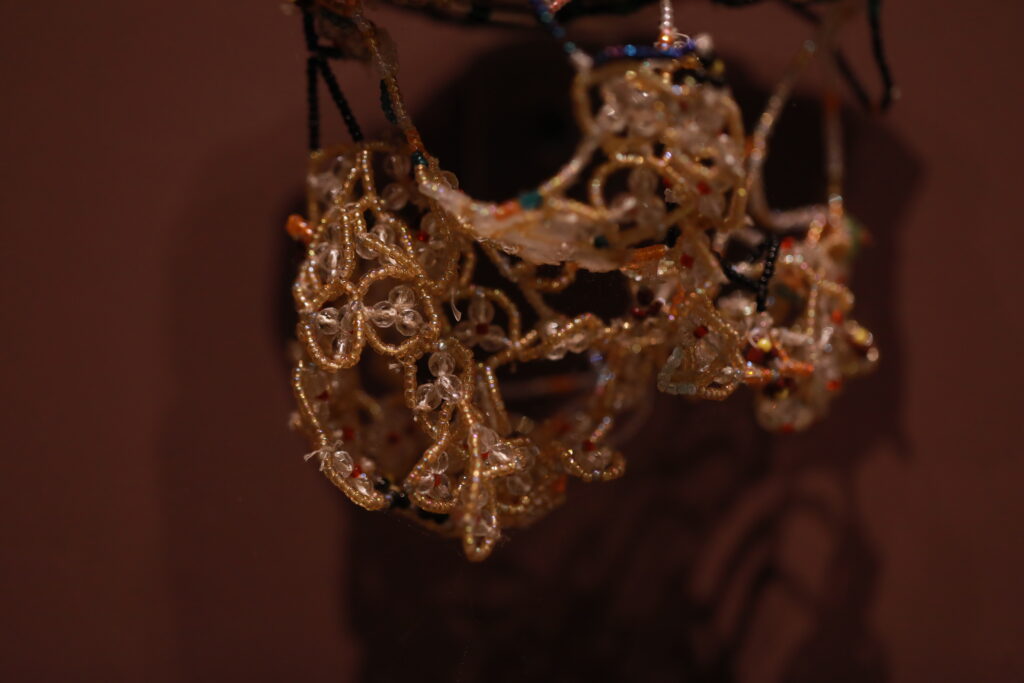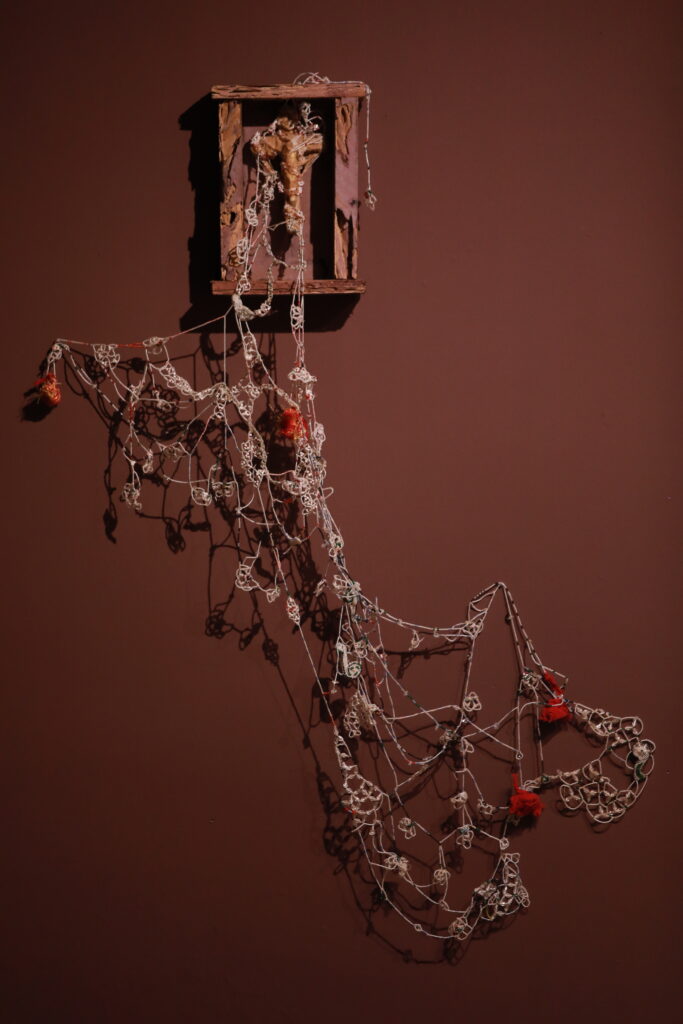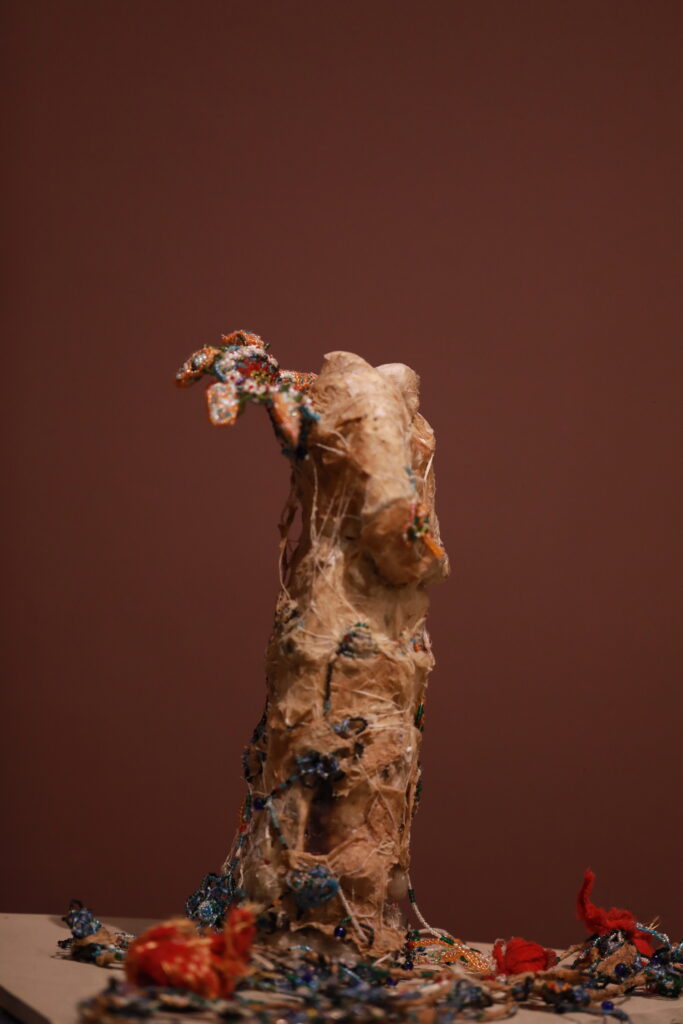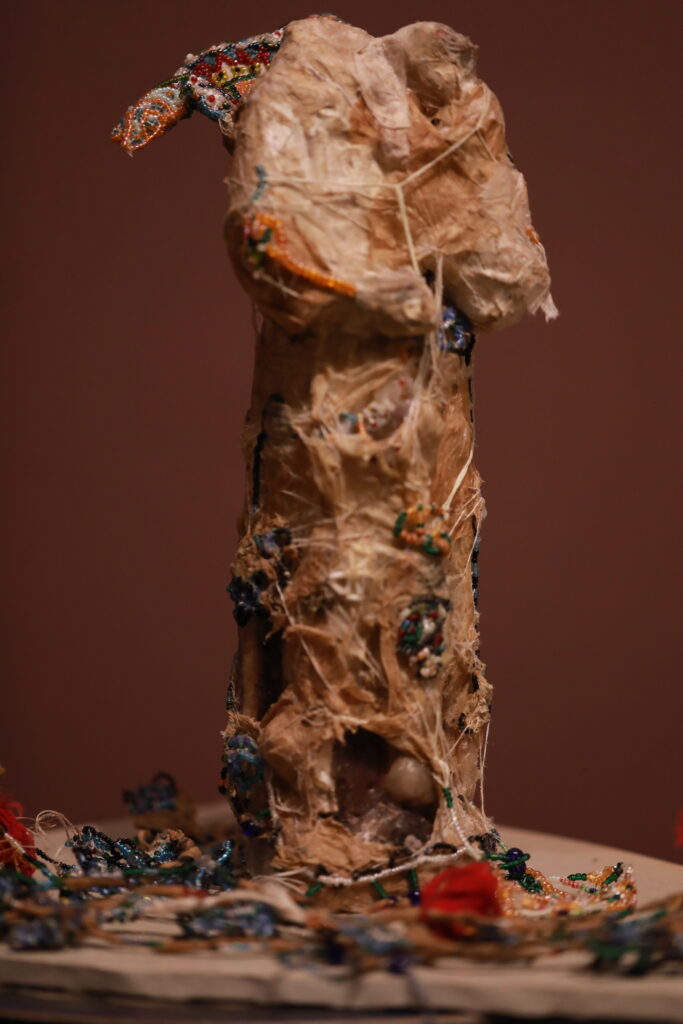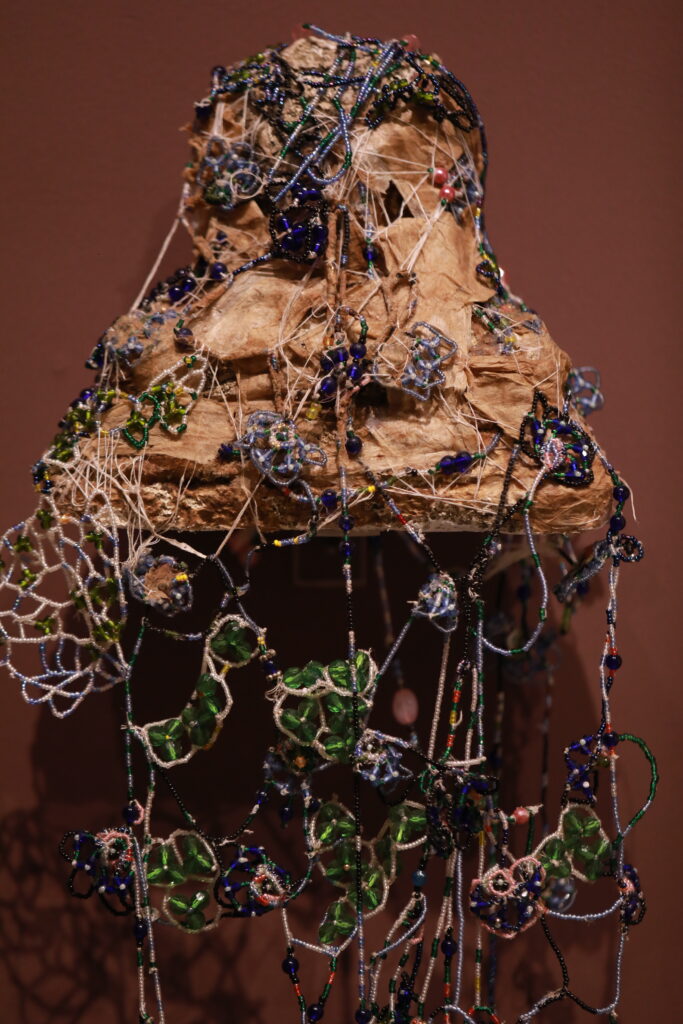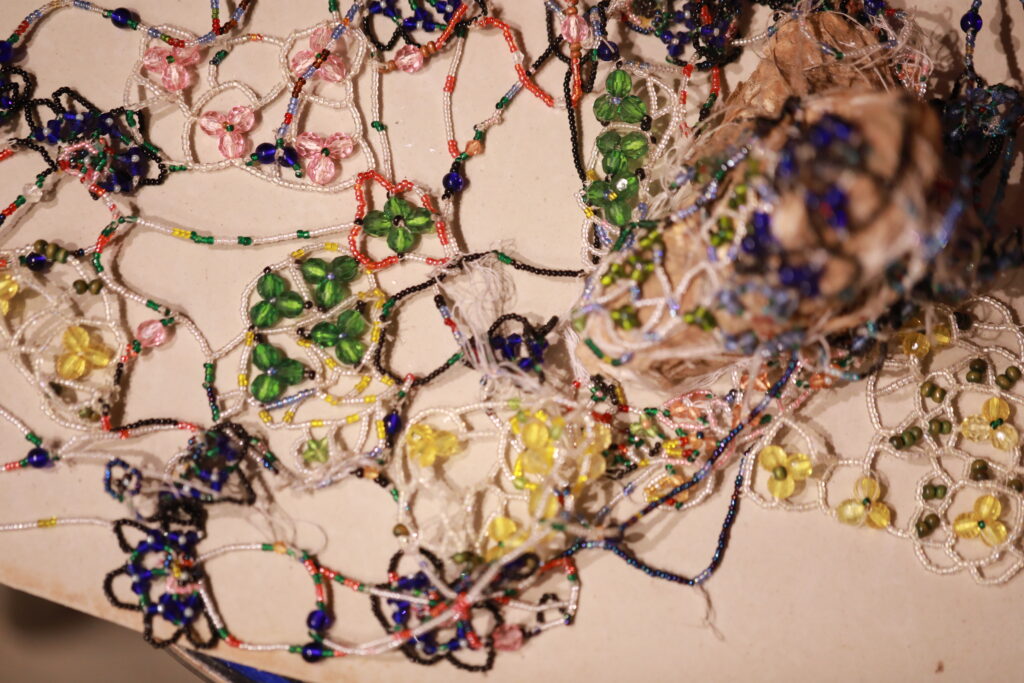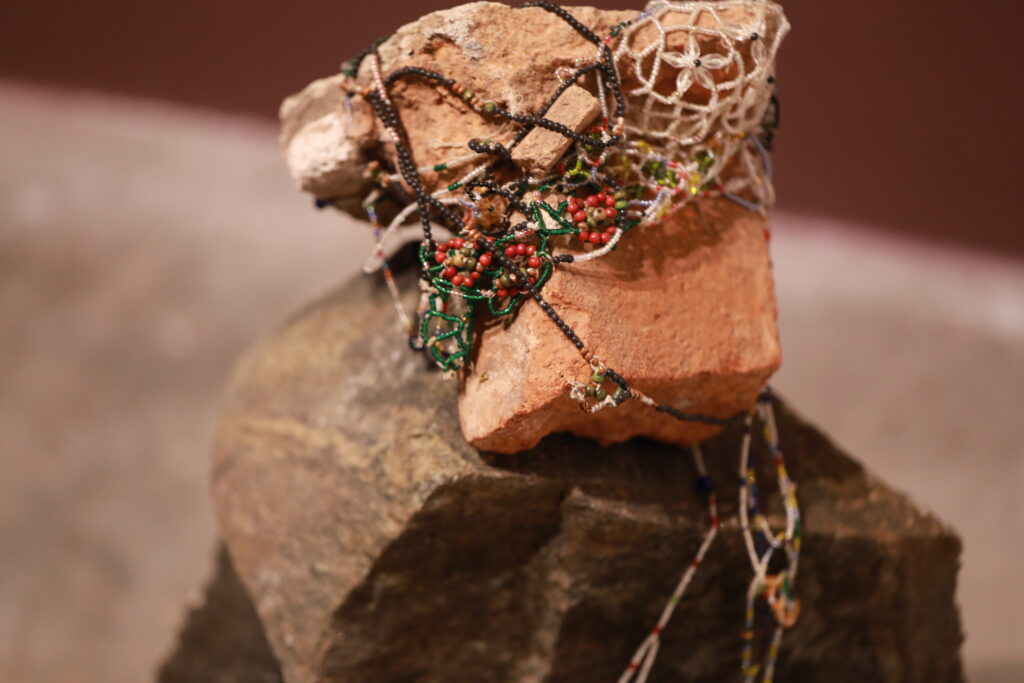මේ භූමිය මගේ නෙවෙයි අම්මේ! ,
இந்த பூமி என்னுடையது அல்ல அம்மே!
I have been born as a regeneration of this land
A Mutant of many pains
Blasphemy
Seeking for salvation
Surging for belonging
This land is not mine, mother!
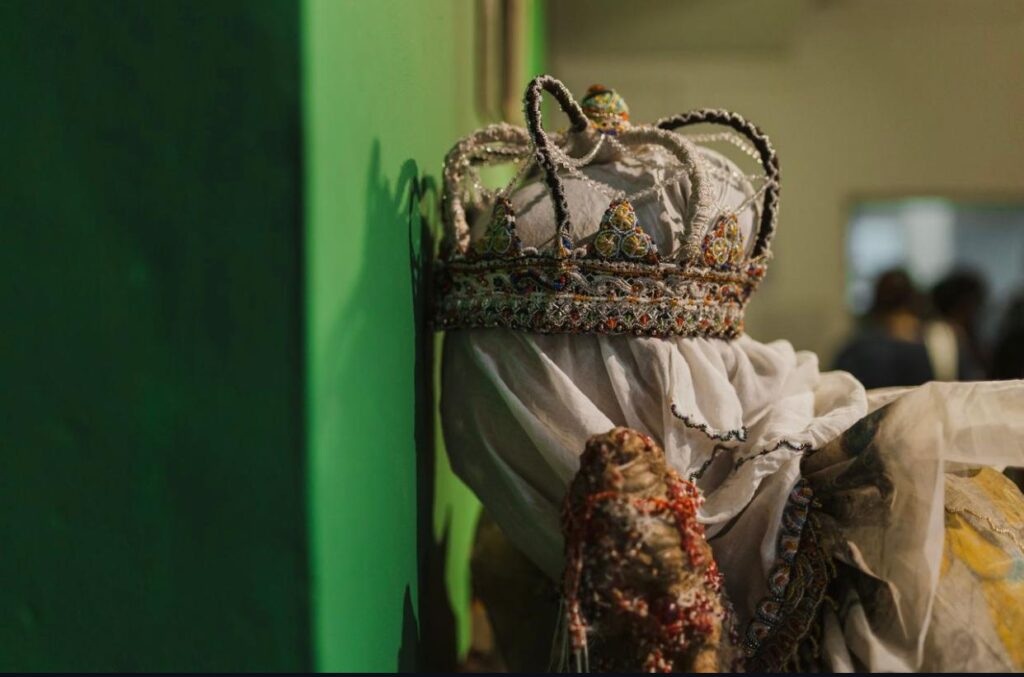
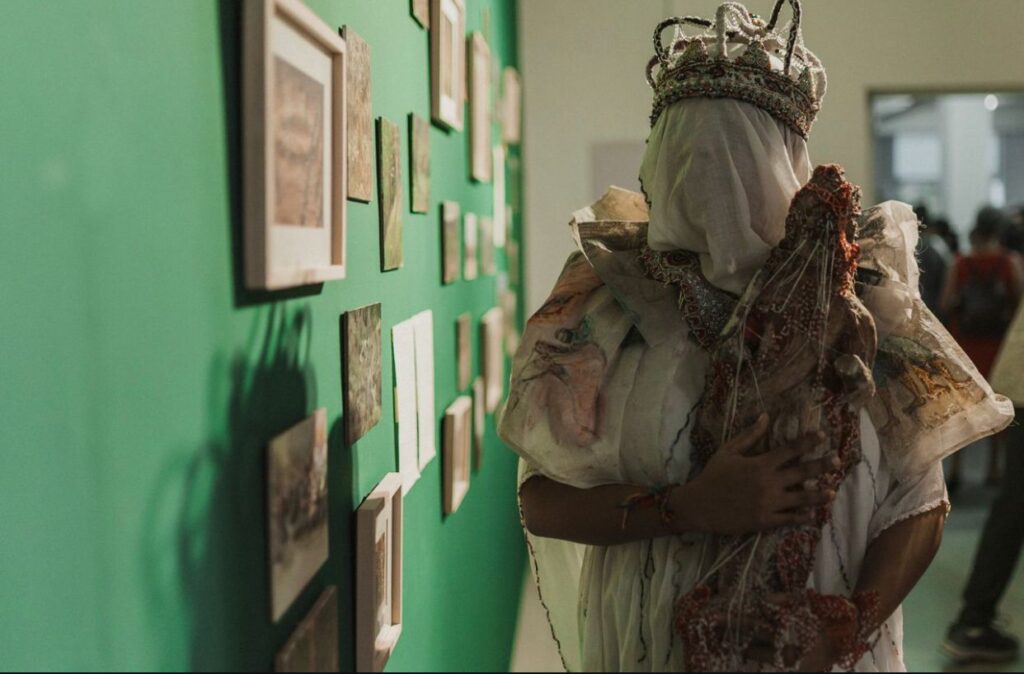
My process thematically begins with inquiries around understanding the symbolic maneuvering of the term ‘‘Memorialization’ and constructing memory, archive, resurrection, gender, and gradual erasure processes within the historical and contemporary socio-political consciousness. Cultivate frameworks to rethink and reimagine futurism amidst the sharp intakes of religious fanaticism, oppression, cultural biopolitics, and gendered segregation within South Asian nomenclature.
My recent research and work emphasize frameworks of racialized cultural identity. The corporeality of bodies and the differential between bodily violence and gendered identity within the historical context. As a queer-identified person, my process begins to unravel the existence of intergenerational trauma that seeps into genetic configurations within our bodies—causing adverse effects within our cellular structures and resulting in mutations, modifications, and reconfigurations within our bodies. Carrying its cause effects intergenerationally into the future physically and psychologically. We begin to find coinciding connections and the existence of queer analogies in the blurred structuralism of the body, self, and identity. Constantly oscillating across time spans as performative convoys as trails of the past, present, and future can be found within the body as a modified organism within each generation, never able to separate each other.
Under the apprenticeship of master Somapala Pothupitiya and Pala Pothupitiya, learning methods of embroidery and textile making of ceremonial costumes, distinguished under the southern Matara regional curative tradition. I begin to rethink and analyze the existence of gendered cultural identity to create a dialogue on representation and historiography. A diffractive dialogue emerges through encounters and conversations during this period to translate and decode pedagogies within the textile and rituals. There are hybrid entanglements within these performative practices that branched out to south Indian cultural attributes to influences of institutional Buddhism and Eurocentric colonialism.
Its “Theravadic” Buddhism-influenced philosophical branch explains the existence of the soul and identity as a biomorphic entity. Broadens up newer discourses; around queerness within materiality and figuration. A territory considered taboo, even within the community of practitioners by ethnographic researchers.
Intercept the rhetorics of the attire’s talismanic textile patterns, origination, transformations, and embodiment. We begin to trace the existence of the body, self, and identity within the symbolism of mythology, oral narratives, and historiography. Creates an urge to reconceptualize and demystify these anthropological portrayals of the body and identity.
Therefore Anthropology of an experience means how an individual receives experiences of their culture and events by their consciousness. How representation, performances, objectification, and texts create a dialect with lived experiences forms the experience of understanding the formation of cultural objects.
The Crux of my argument is that readings of histories and concepts become problematic for the structures of anthropological objects. The problems generated through the practices constitute them and whether we want to consolidate or find sensitized methods that provoke cognitive questionnaires on these subjectivities.
Therefore the work takes in an embodiment of Recreating an interplay of narratives through visiting the mythical past administered as a core subject to speculate materials of histories, ‘old’ colonized entails layers of segregation, ‘cultural’ stories designed for viewers to engage and embrace their differences through tracing and intercepting as a form of mapping the past and the present. Recreate a mutant dystopian figuration of resistance within the portrayal of ‘Sri Lankan’ identity.
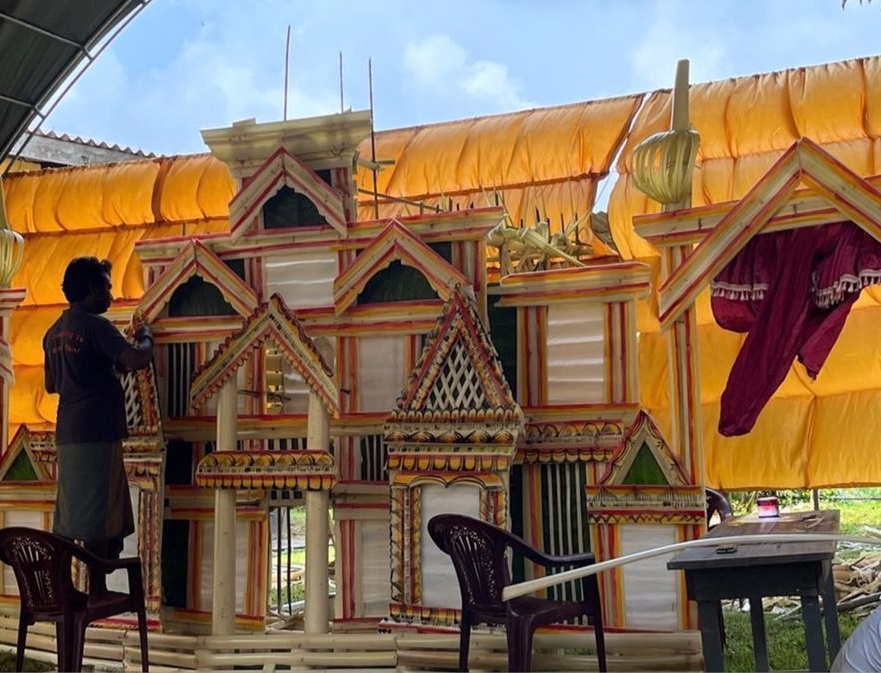
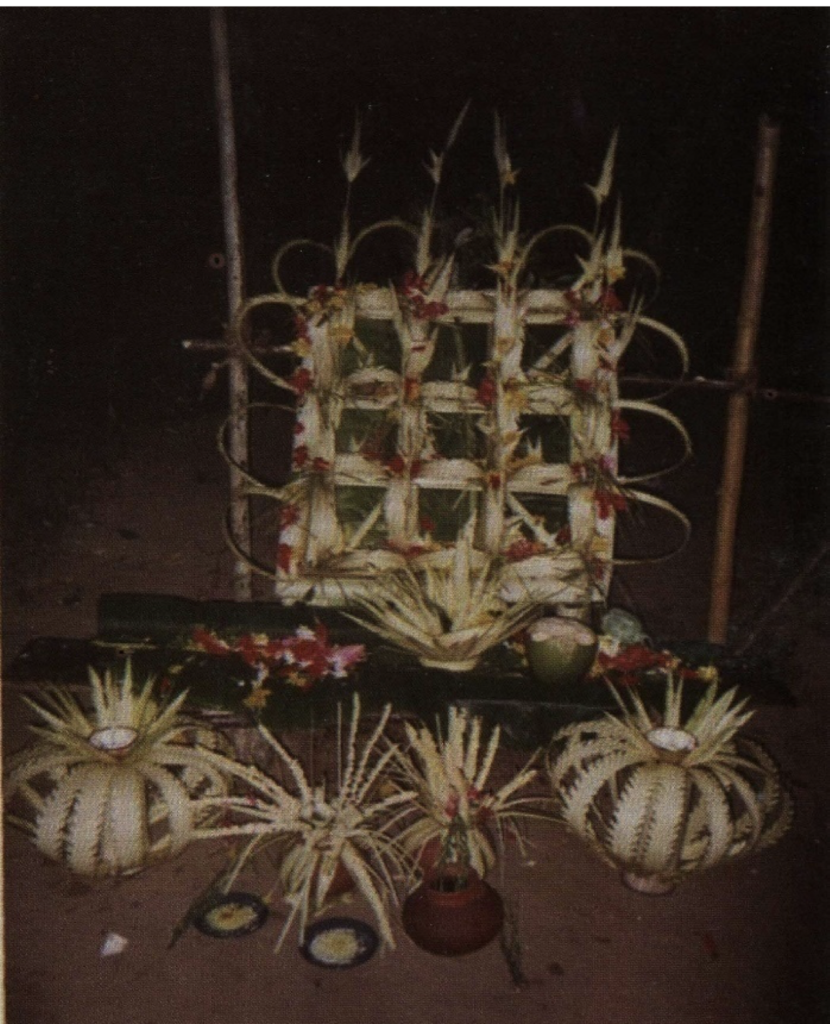
Gammaduwawa ( Palaces) is a sacred stage for offerings ,built specifically for ritual purposes in Shanthikarma ( curative rituals) by the community for the guardian deities of Sri Laka; pattini and the other three guardian deities are called out for protection and fertility. We observe within the recent years ,from the time of 2009 ,(2009 is considered the last year of 3 decade civil war period)this community gathering rituals completely shifts its purpose; altering its core elements such as healing, togetherness and interconnectivity.
We can observe these rituals symbolically garnered these alterations in favor of the state’s implications to thrive on Sinhala Buddhist nationalistic sentiments . Sometimes traditional motifs and ritualistic landscapes drastically changed according to these agendas of the state or catering according to the tourism industry. There were significant changes that affected to the core originality of the cultural aesthetics , significantly diminishing its ancestral knowledge implications and succumbing to these infrastructures for survival.
Reclaiming spaces, cultural portrayal, trans materiality, and decolonization through building Speculative ephemera from oral narratives, rituals, and archaic materiality.
Haraway recognizes that ‘figures collect hopes and fears and show possibilities and dangers. Both imaginary and material, pure root peoples in stories and link them to histories’ (Haraway, 2004, p. 1).
Taking the role of an anthropologist mapping systematic process of erasures (Chrono phage) through collecting these discarded icons are considered omens by folk belief, traces onto spaces and landscapes of past and present volatile histories. Conducting visits to sites of ritualistic performances, religious presence, and abandoned architectural spaces relates to epistemological historiography. Creates curiosity to make disjunctive narratives upon their looming existences against their didactic origins.
Later on, Integrating them into residuals or symbolic objects of resistance.
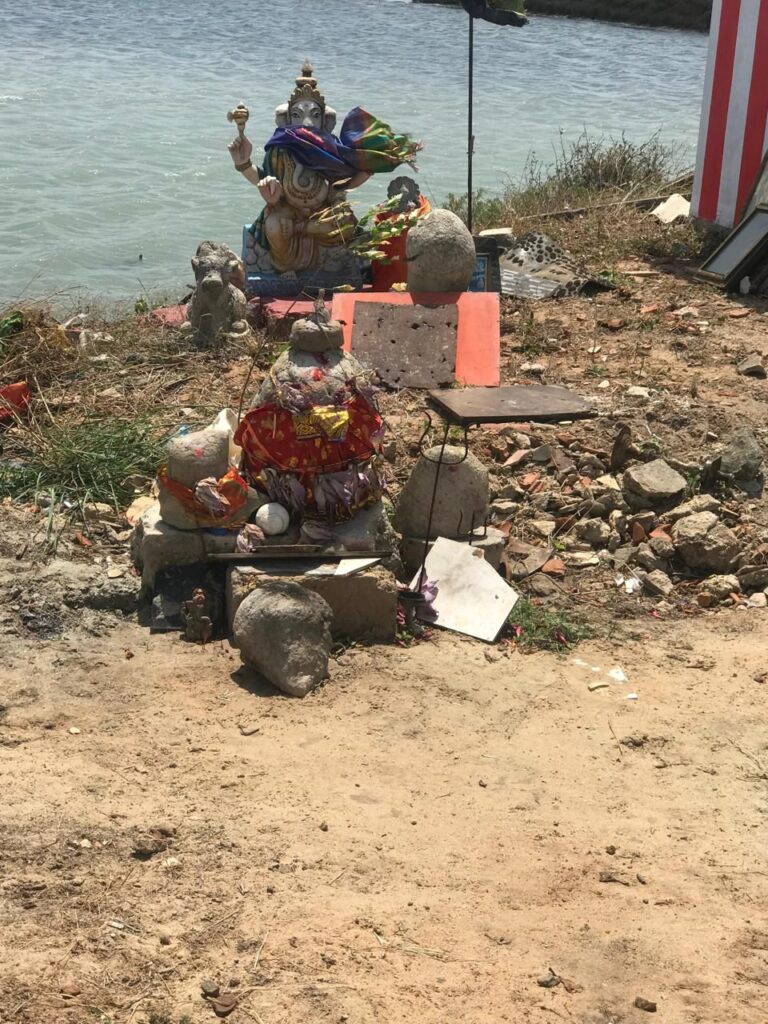
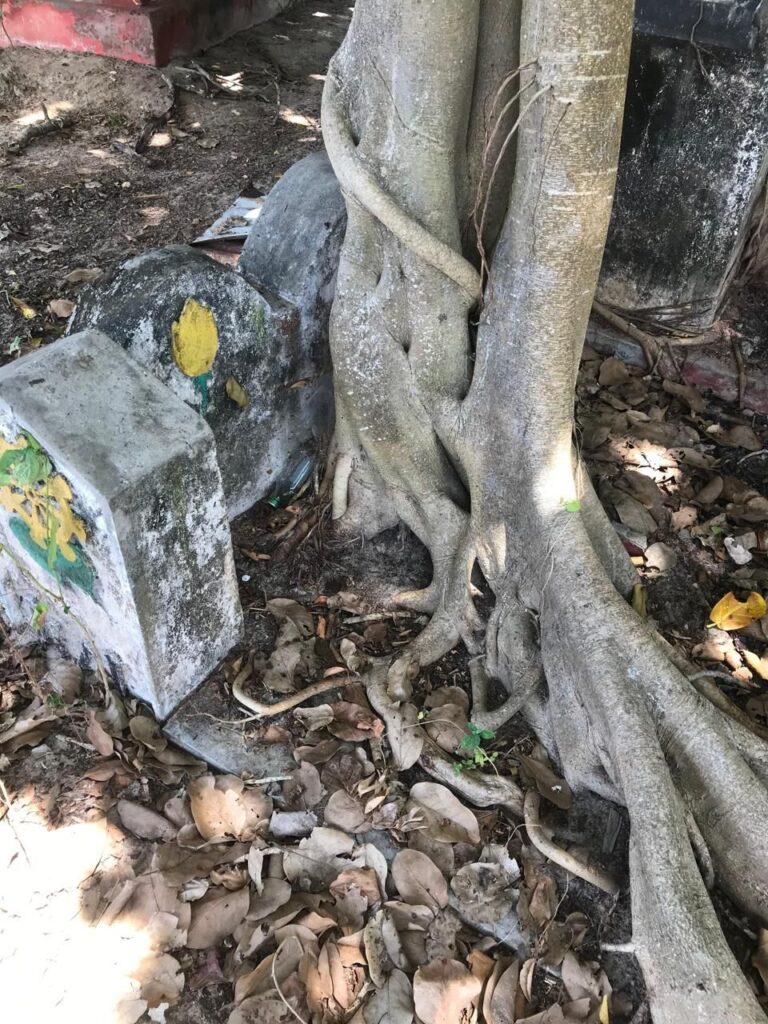
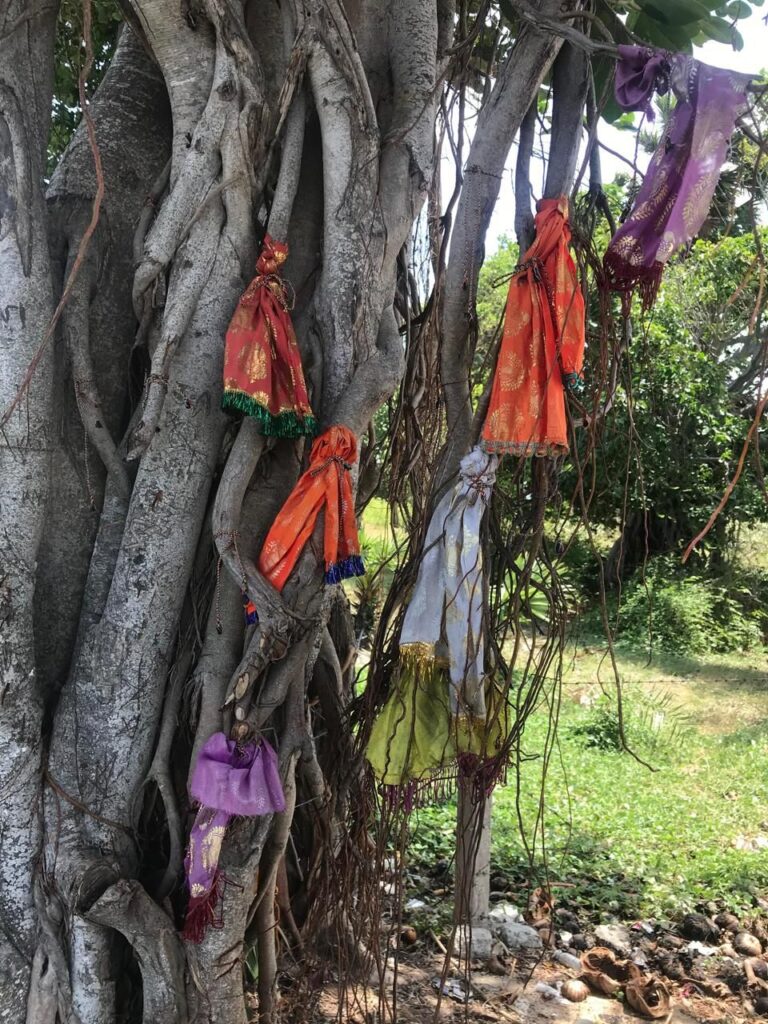
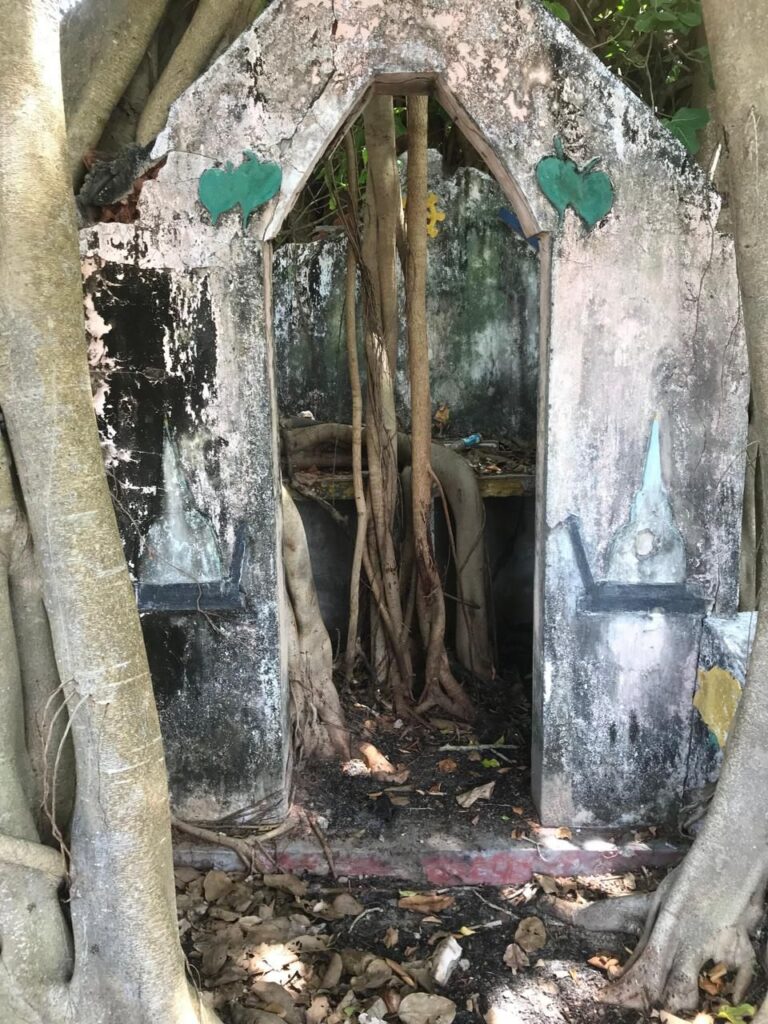
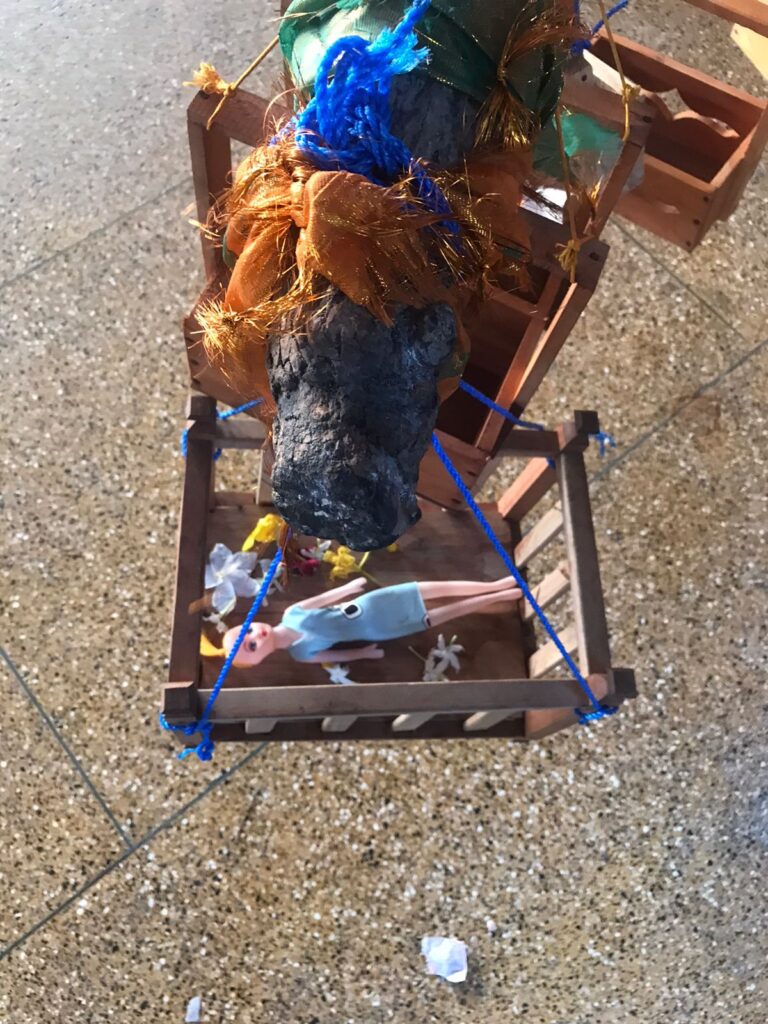
In curative ritual traditions of the Matara region (geographical area), artisans believe the entities exist as transmigratory bodies/ fluid forms within ecosystems. My work observes these formations or substances that materialize as sacred icons but are mundane substances. A pile of rock formations near a water body or under a tree becomes a site of these existences. A sacrilegious form that at times exists within contours of debris within the landscapes of hidden narratives of trauma and foliage. There are heritage sites and sites that succumbed to deterioration located within Colombo. I tend to collect debris or fragmented essences from them. Such as the demolished Rio complex or the abandoned houses in the Jaffna landscape tend to become substances/ materials within each composition. Debris taken over by the roots and moss tends to become another existence of these sacrilegious ecosystems that have taken the shape of long-extended mutations of time and biotopes.
What is to be considered natural or permanent, do objects and their materiality embody a trans-materialistic, queer consciousness? I collect these objects classified as omens and unnatural. It could be expired toxic tear gas canons collected from sites of protests. Bear witness to the 2022 revolts or a sculptural icon mapping the violent entail of deepened consciousness of fear. I begin to access their materiality and objectivity, gradually allowing them to transition. To discover a connection between their psychic and physical manifestation.
Materials embracing their chaos and monstrosity are pictured as disfigured, mutated figurines. The rendering resurfaces the monstrousness by suturing and layering a skinned being to create an assemblage of surgically constructed flesh with beaded extensions protruding from their bodies. Their grotesqueness amplified as if their humane signifiers had gradually peeled away.
These mutant corporeal beings embedded with the symbolic representation of the self, body, and identity are subjugated to domains of systematic segregation, violence, and post-colonial views that have been fostered for ages. These fragments interconnect each other through extensions recreating a map of intergenerational carriers. Hence they exist between the territories of ritualistic objects or as artifacts or times as signifiers or testimonials bearing flukes of intergenerational agitation.
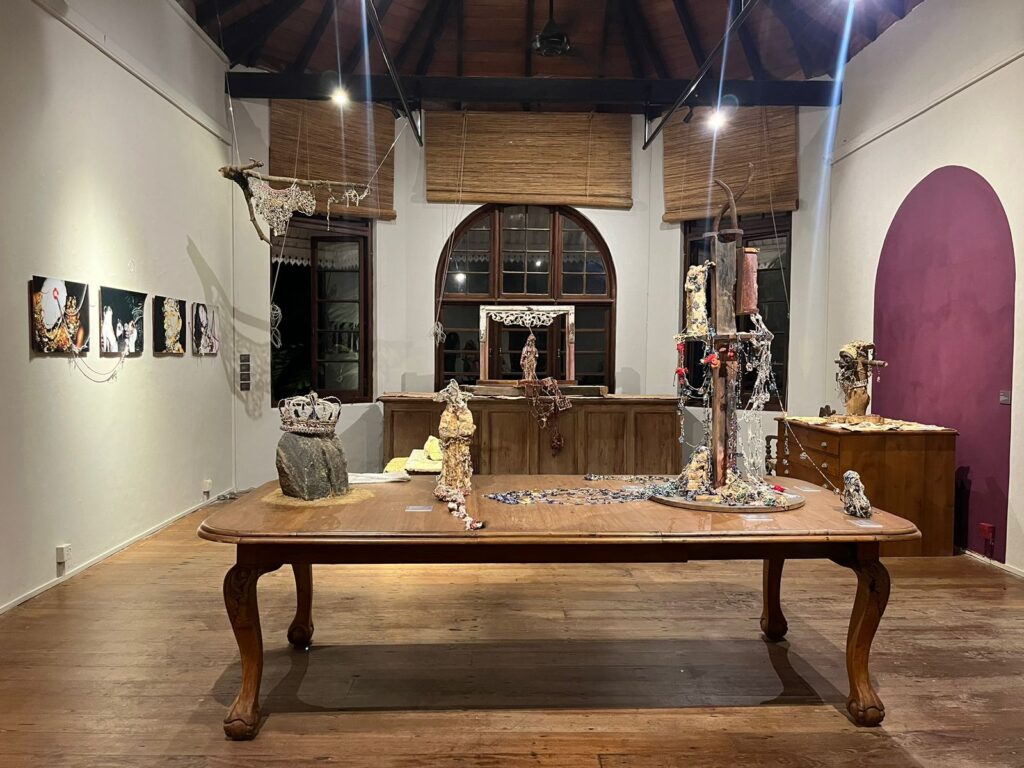
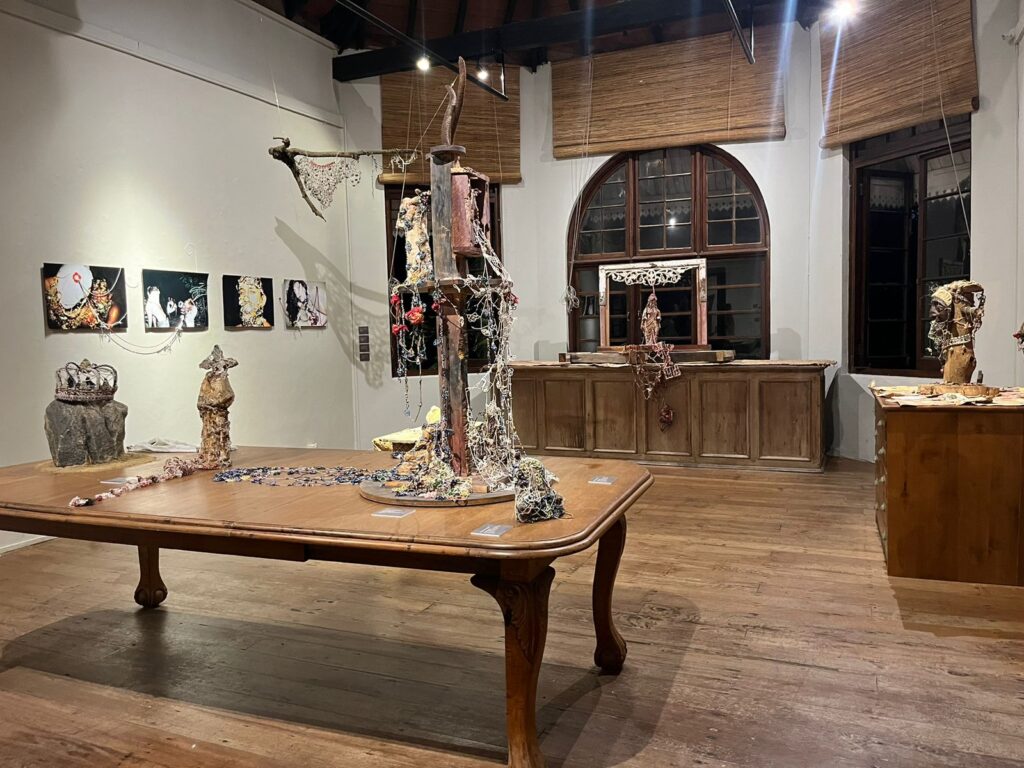
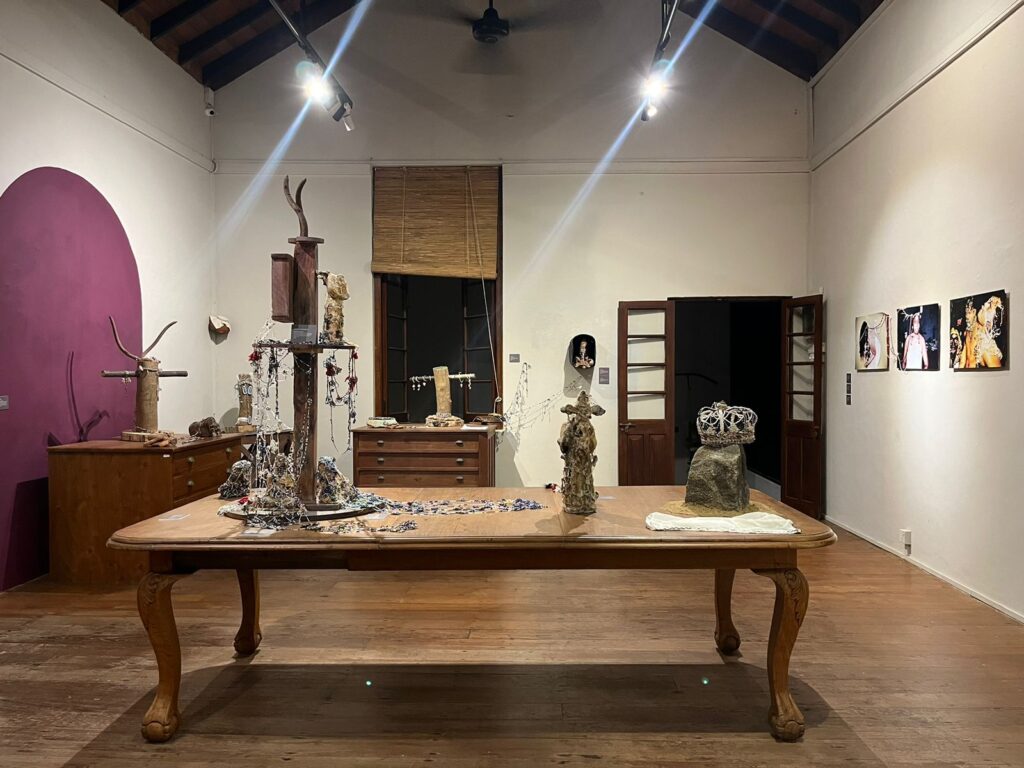
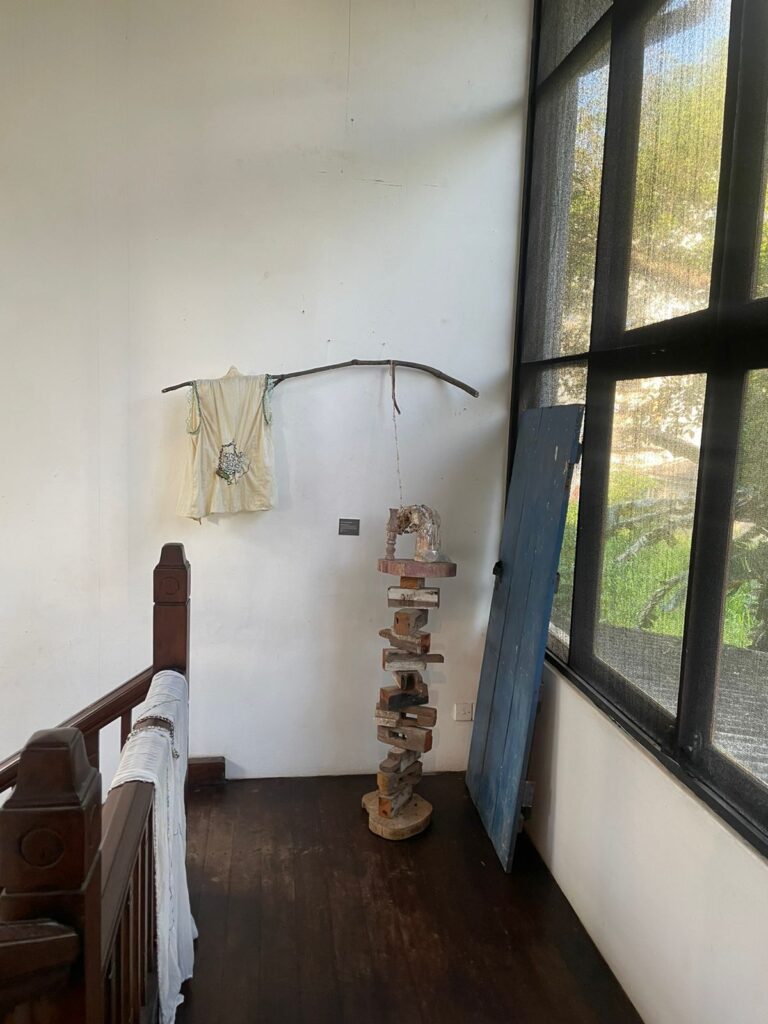
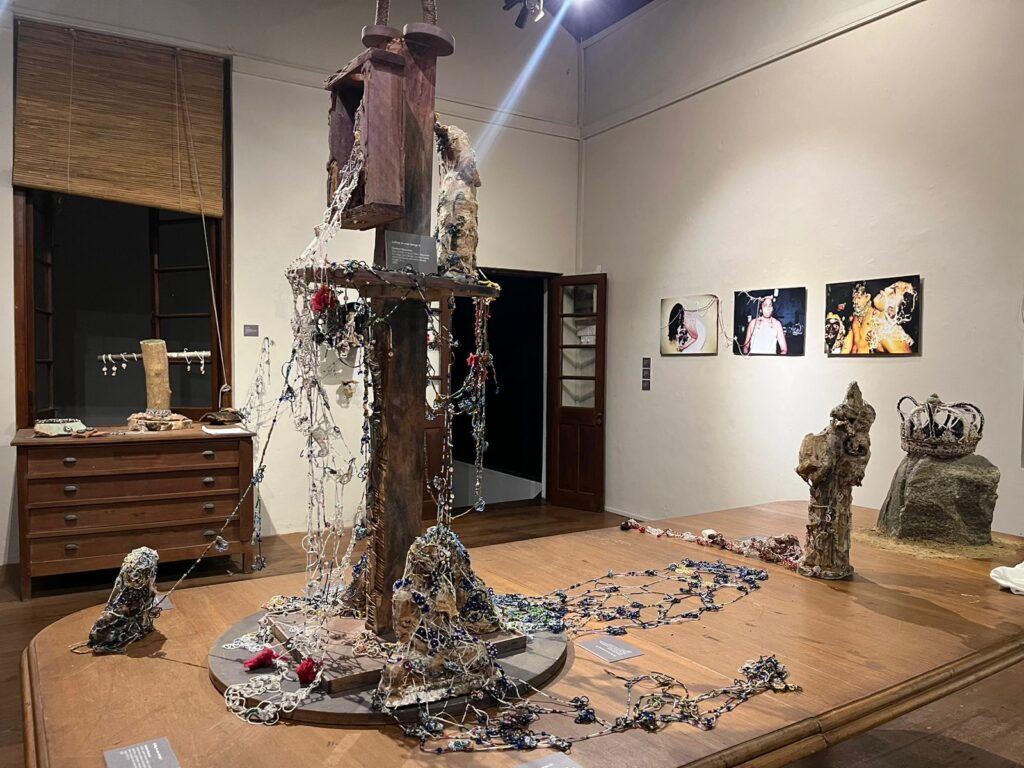
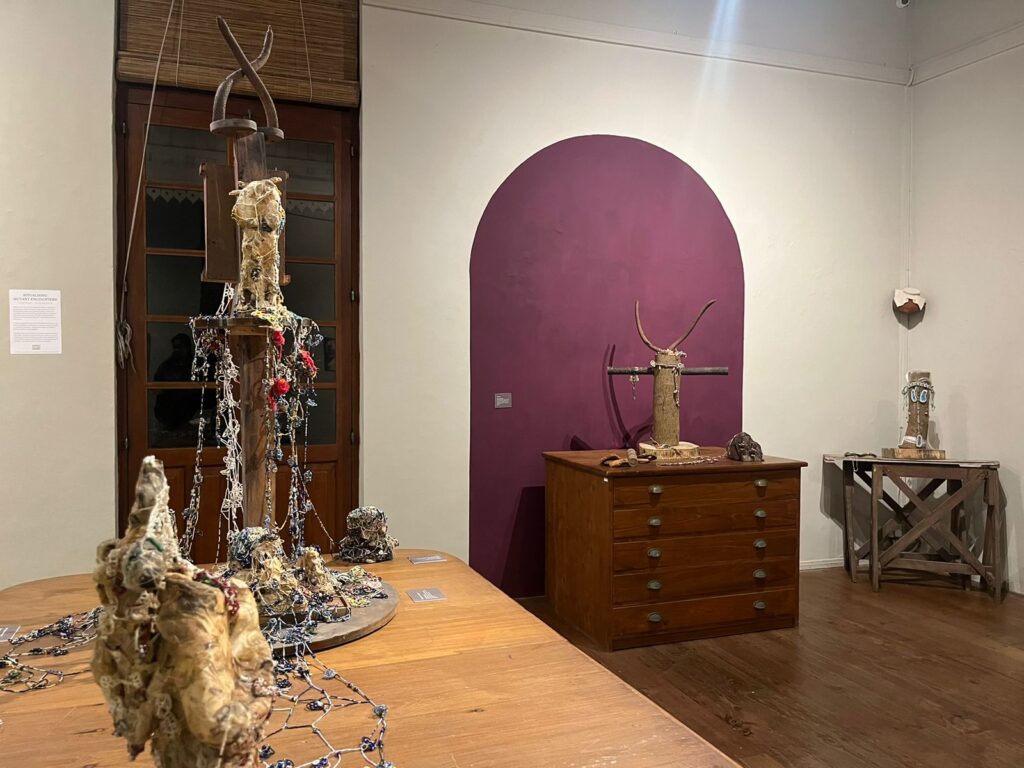
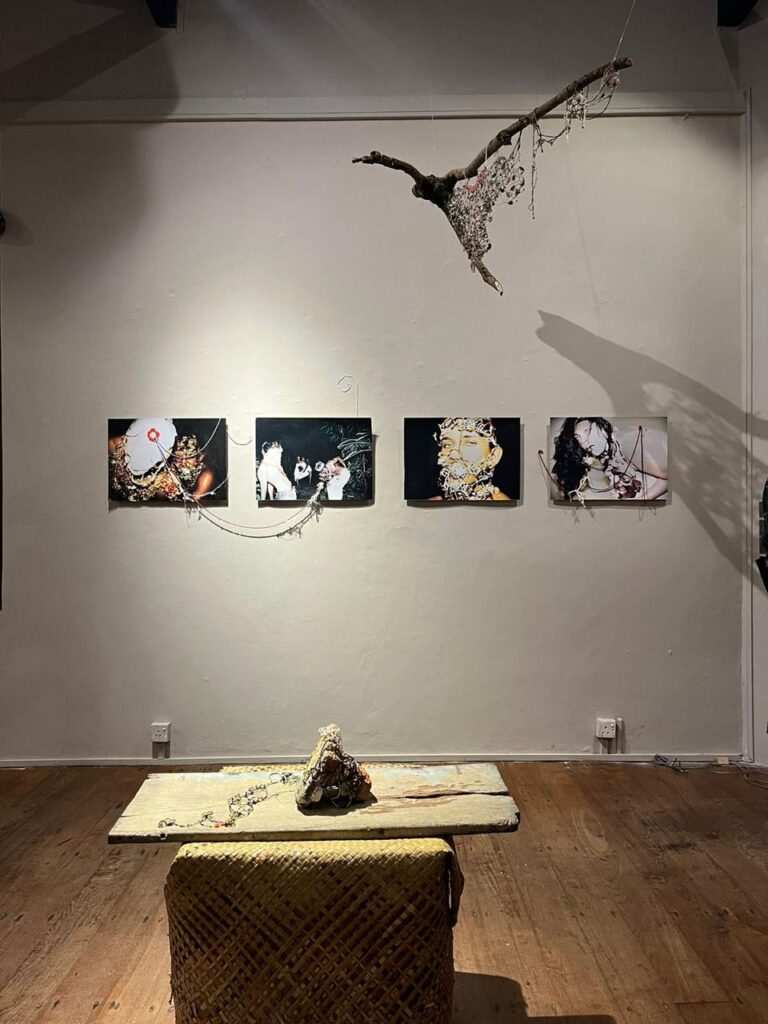
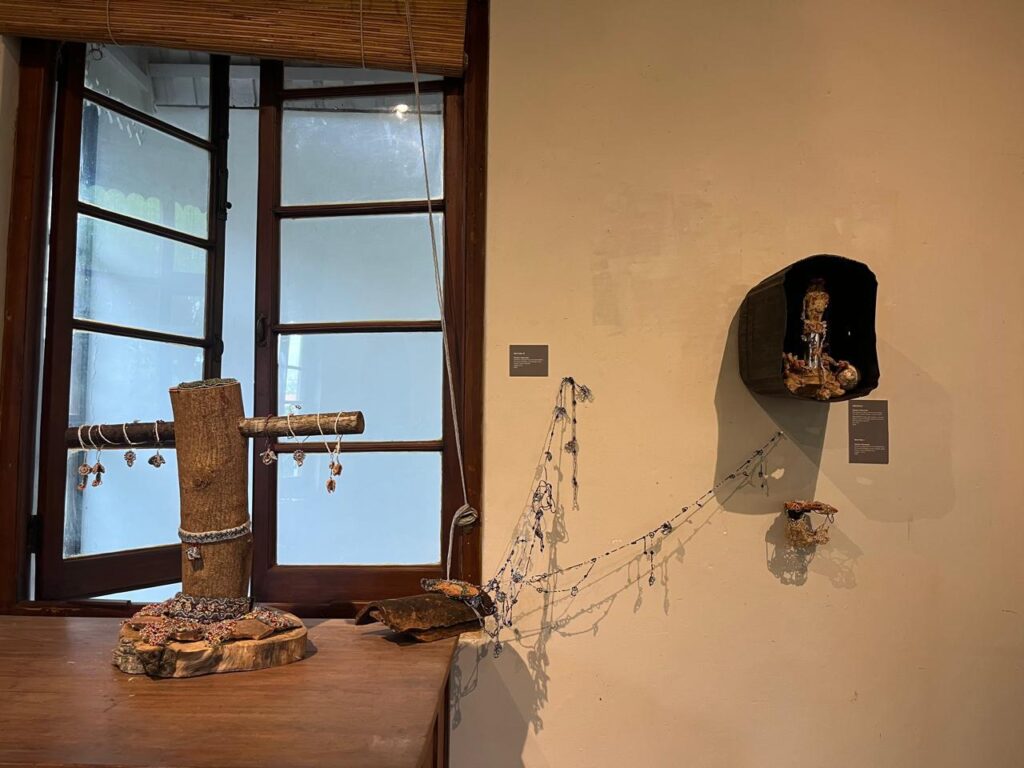
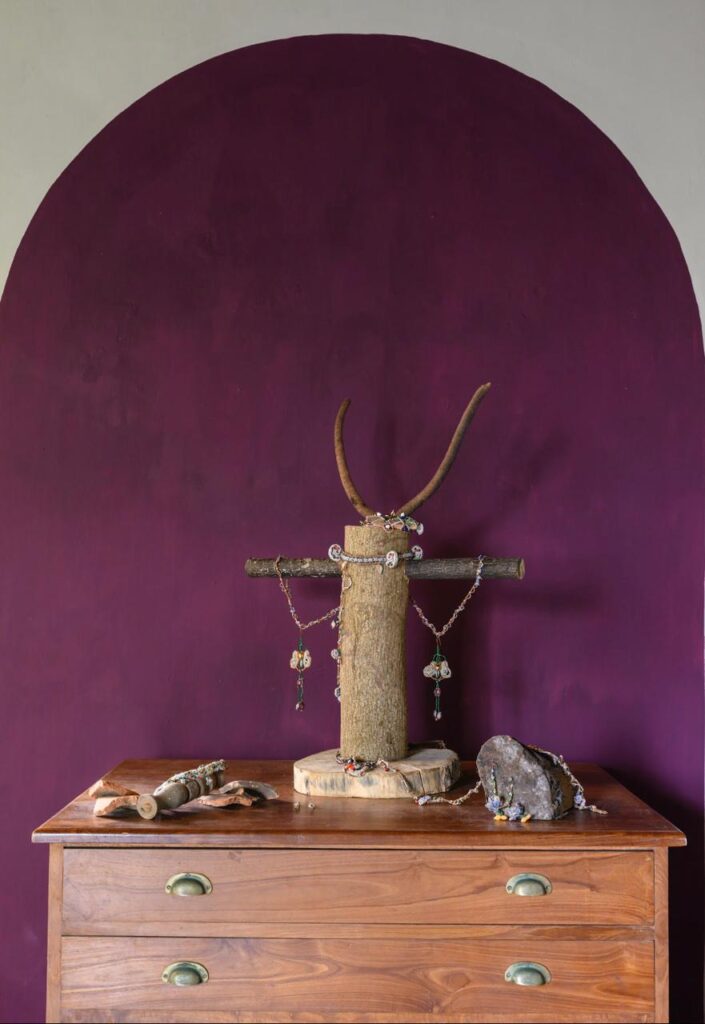
Create a ritualistic performative that draws parallels to the mythical spaces of the divinity “ Black prince and the queer embodiment. Ritualistic space for offering well as connectivity. A space that carries fragments of the existence of the present queer body.
In this series, the sculptural formations will be displayed as a form of Somatic entity as part of a ritual. At times the ill person is also known as “Aathuraya”’s body extracts; hair, nails, and saliva are offered as extensions of the body. These objects are called “Piddeni”, offered to the entities during the ritualistic process apart from foods for the entities to devour. So an installation is recreated in the form of a “ Thovil” act. ( Healing ritual is used here to contextualize the Thovil term departing from the term exorcism). These sculptures exist as beings in the form of entities within the act and the performers are the ailed people within the act.
In the form of Assemblages, these sculptural beings will be made from fragmented structures carrying forms of debris or sediments collected from various sites. These objects transform into repertoires or offerings that cascade their tale’s continuity onto a symbiotic structure. These beings connect or extend elaborate textile extensions protruding or intertwined by the ecological formations that have surrounded these forms or erupted from them with time. They are beings enclaved from their original forms, surroundings, or subjective predecessors but emerge as conduits or carriers.
Narratives of these assemblages create reimagined somatic beings that are fusions of ritualistic, uncivilized, and mutant testimonies of reproductive trajectories.
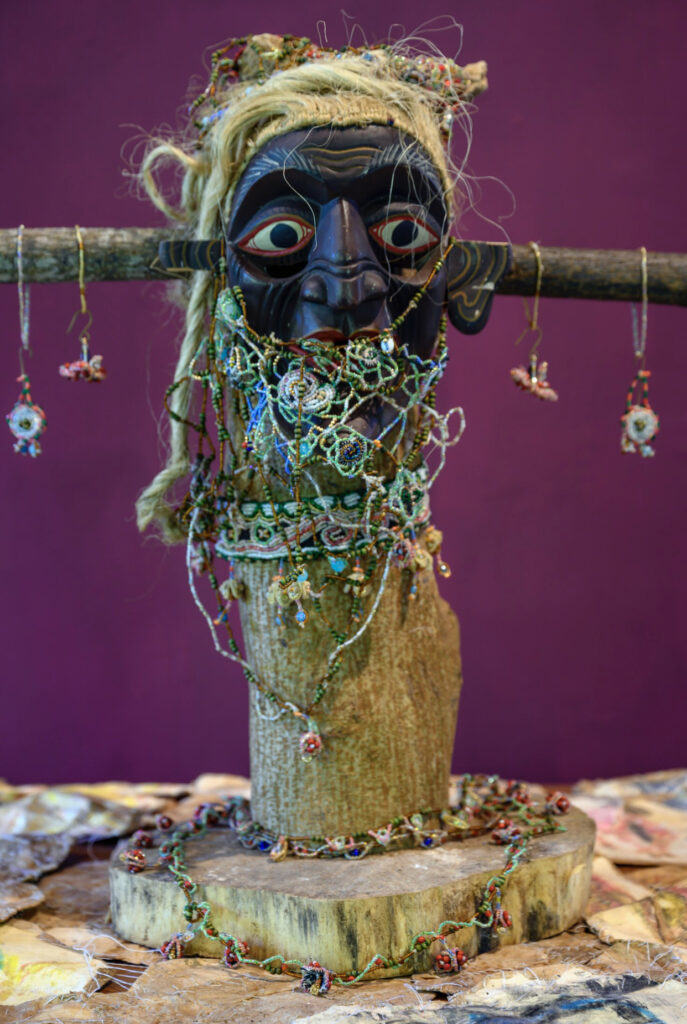
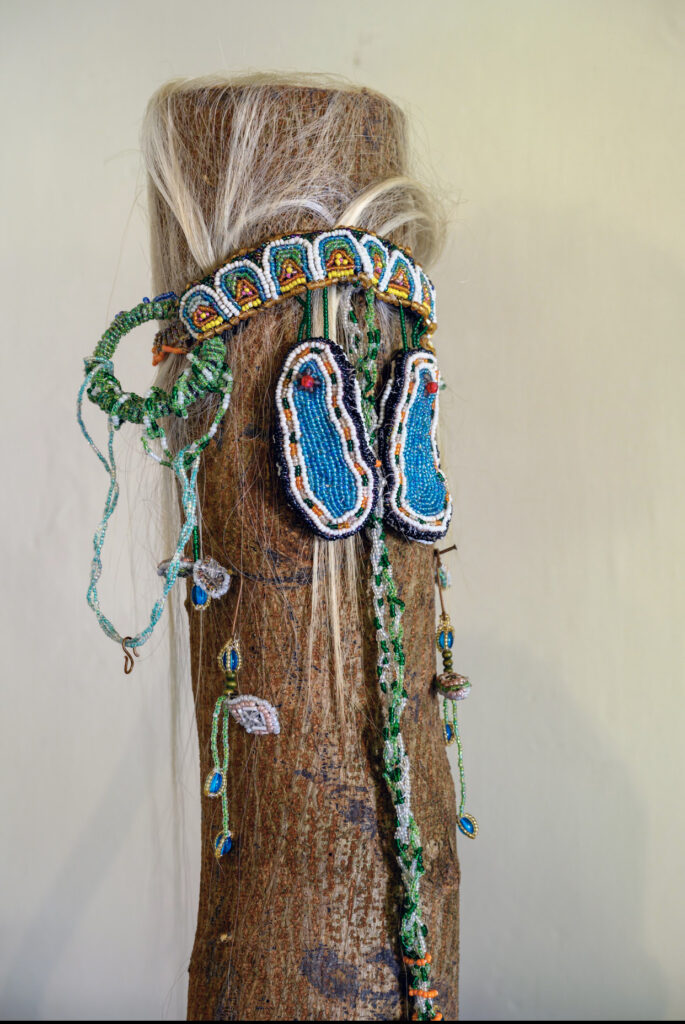
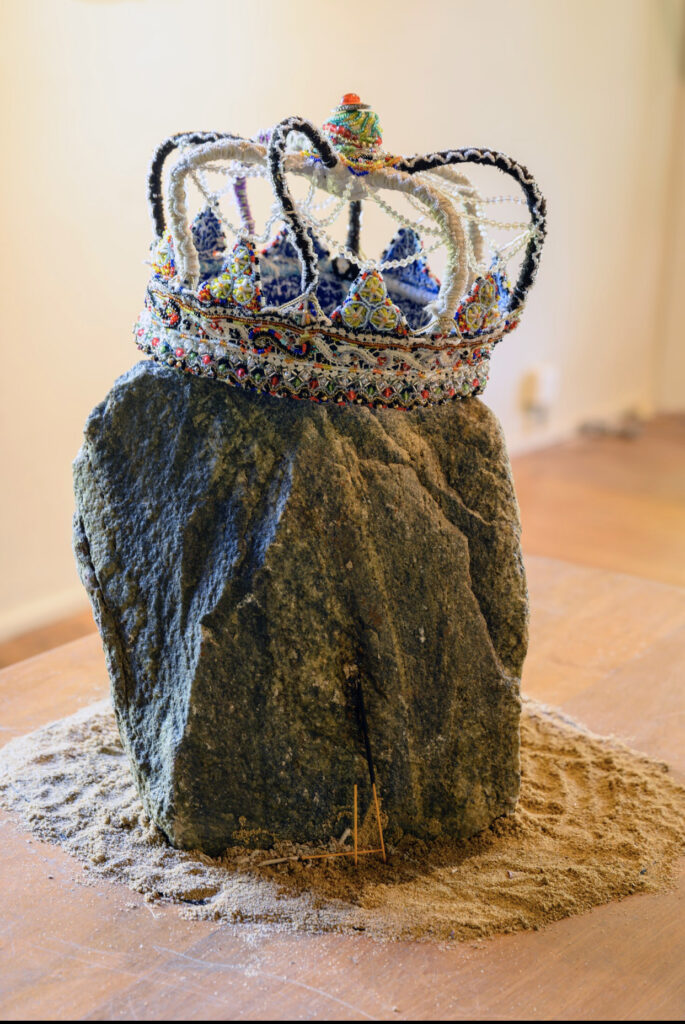
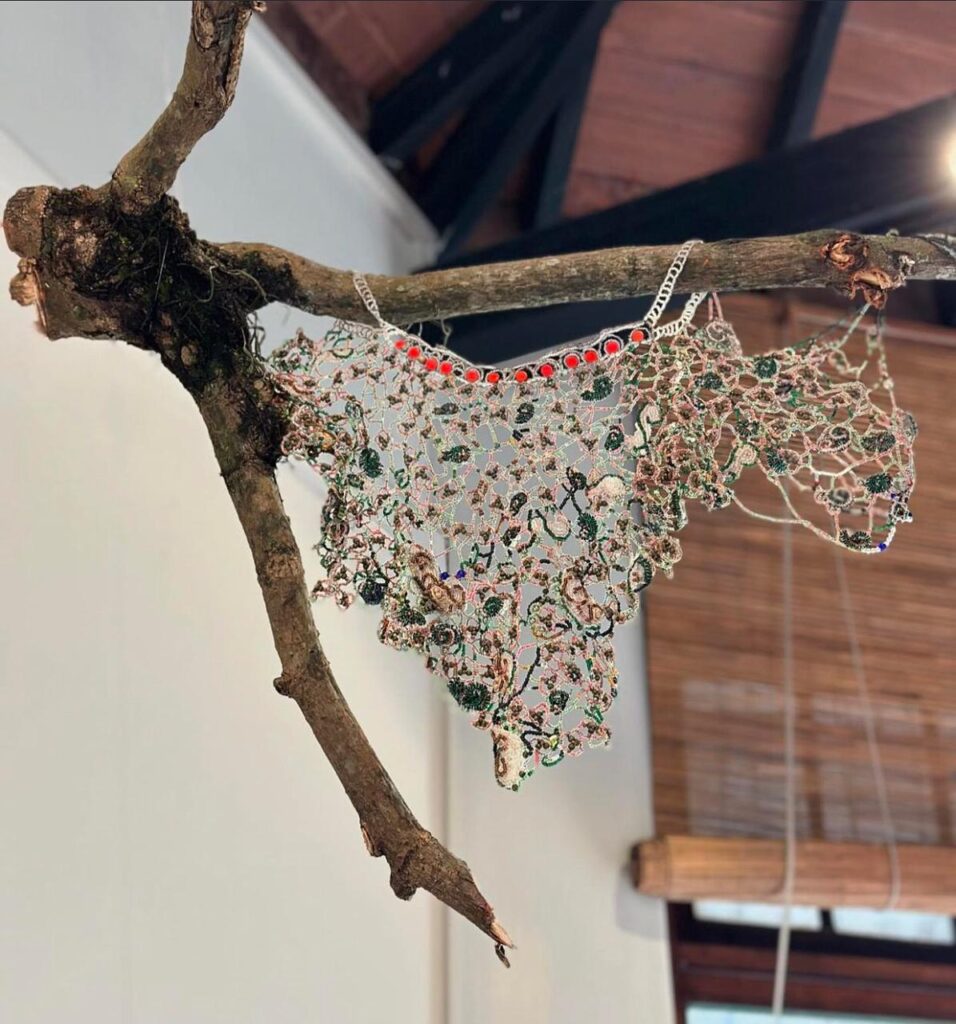
The speculative tale of the Black Prince otherwise known as “Kalu Kumaraya ” becomes the main protagonist of this series. The entity connects with reproductive tales, the main cause of baron women, infant deaths, plagues, and women discarding men from sexual intercourse, it’s in the popular form of an incubus being.
Unraveling the entity Black Prince’s formations and aligning the rituals performed throughout the country by the Sinhala and Tamil communities, there was a coexistence immediately created by the ancestral knowledge sources. Yet disparities emerge as the written ethnographic sources showcase otherwise or perhaps another direction to understand these practices.
While deconstructing the written analysis and the imagery, I began to trace the roots of its attire formation. There are disparities in portraying the “black prince” identity within written historical material and oral ritualistic narratives known as “Janapravada. The black prince’s depiction within this document provided avenues to reiterate a narrative of a being succumbed by the racial-politicalized, gendered, historicized, cultural object or artifact. Its queering emerges as a cognitive repercussion of these constraints as a divine machinery of human consciousness.
Process:
Into thy hands I commend my spirit.
Performative narrative :
Ratnavalli was a deposed princess as she craved for human flesh
her father, made her to become part of Rodiya community
some say….
Her followers worship goddess Paththini / Kannagi (Tamil Hindu goddess), they were the men of the Paththini cult and when one needs to search for ailment from the black prince
She’s called out to show her divine grace
Her followers were silenced by the Buddhist cult even though they were the servicemen of the sacred Bo tree
They were the untouchables and the black prince was born from her black avatar.
My mother witnessed charred bodies called hanging men
There were burning piers that were considered untouchables in the past.
These brittle charred bodies on the grounds, were considered never to be touched
laid as fragments scattered in the landscape.
The ones who revolt are now considered untouchables they are the ones brutally taken away


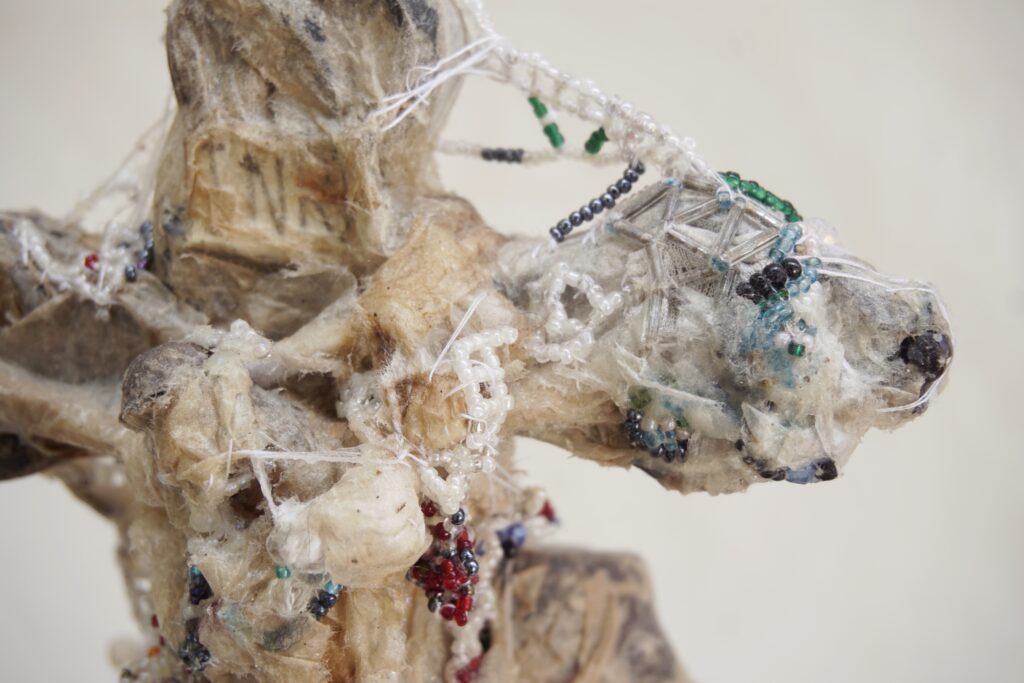

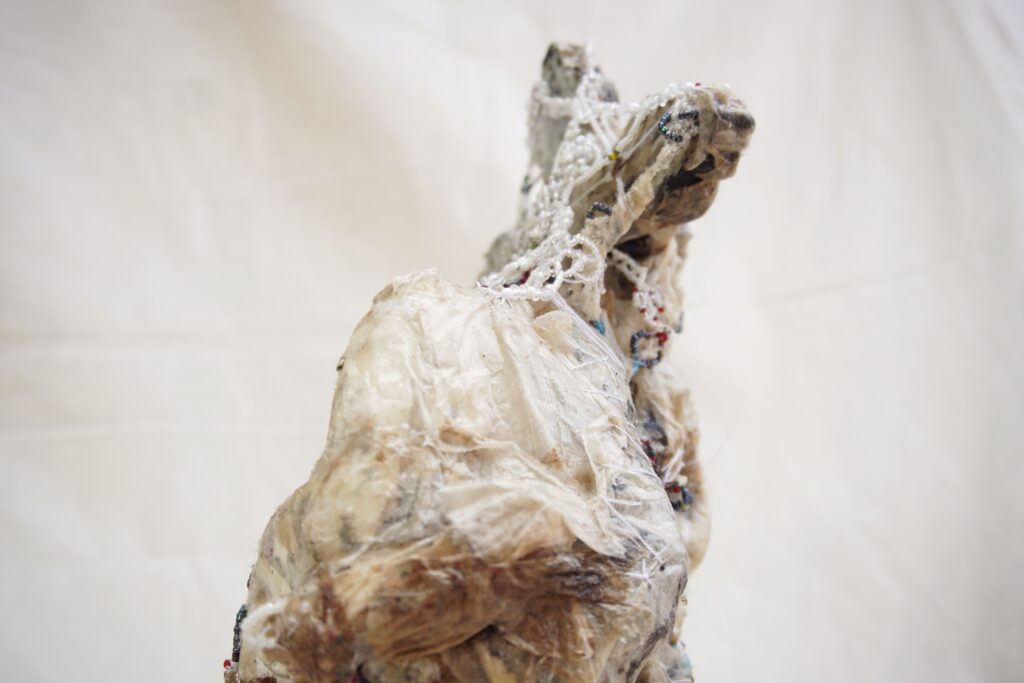
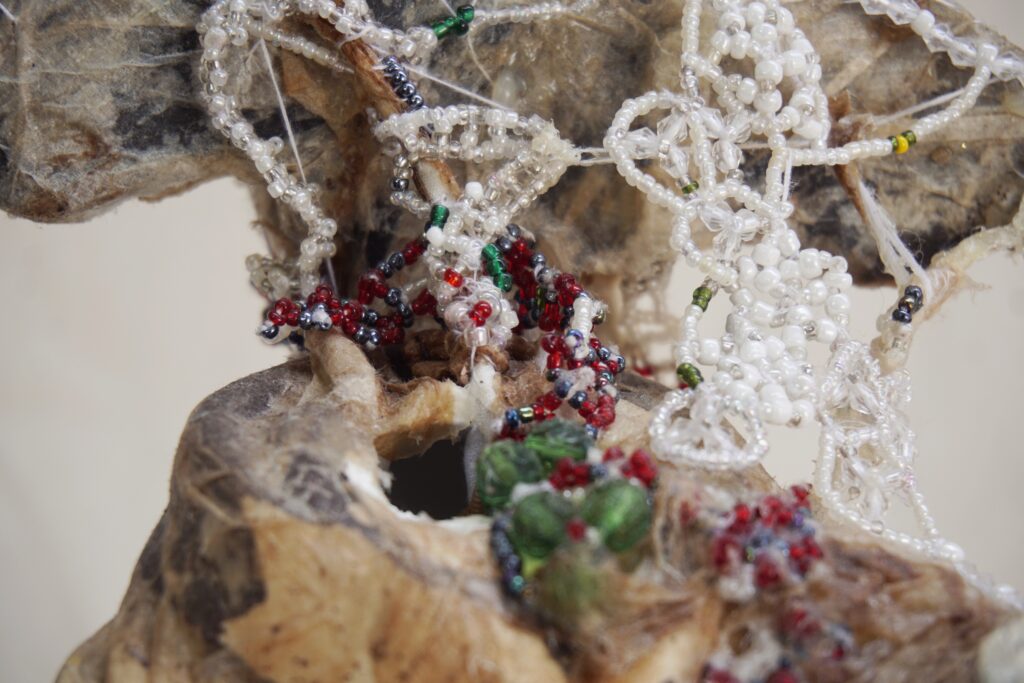
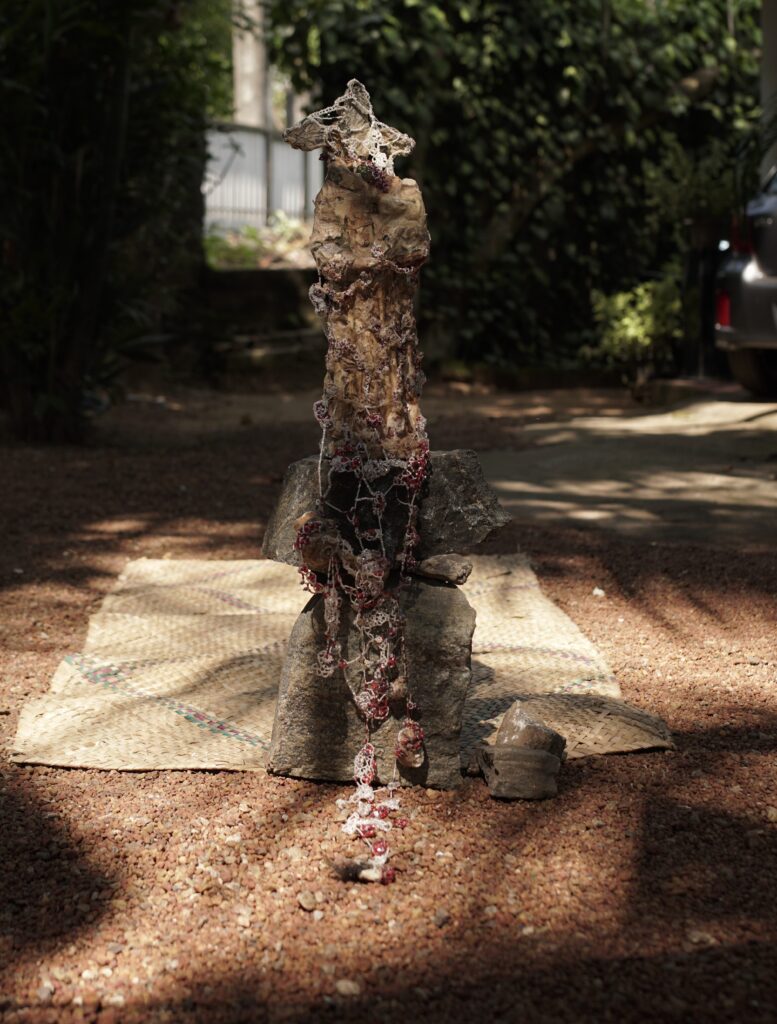
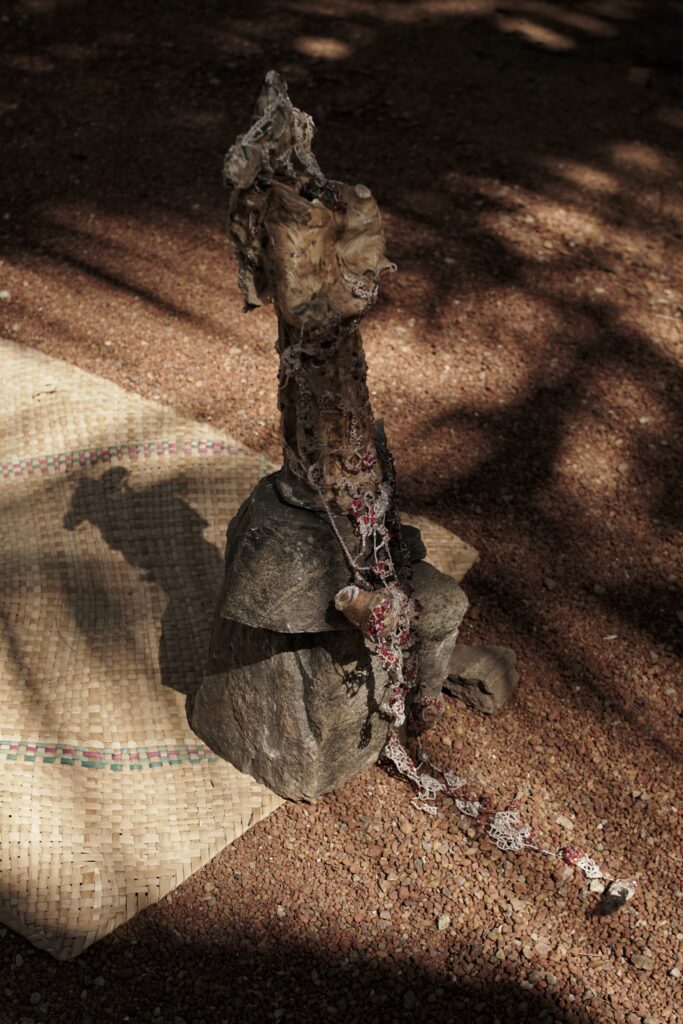
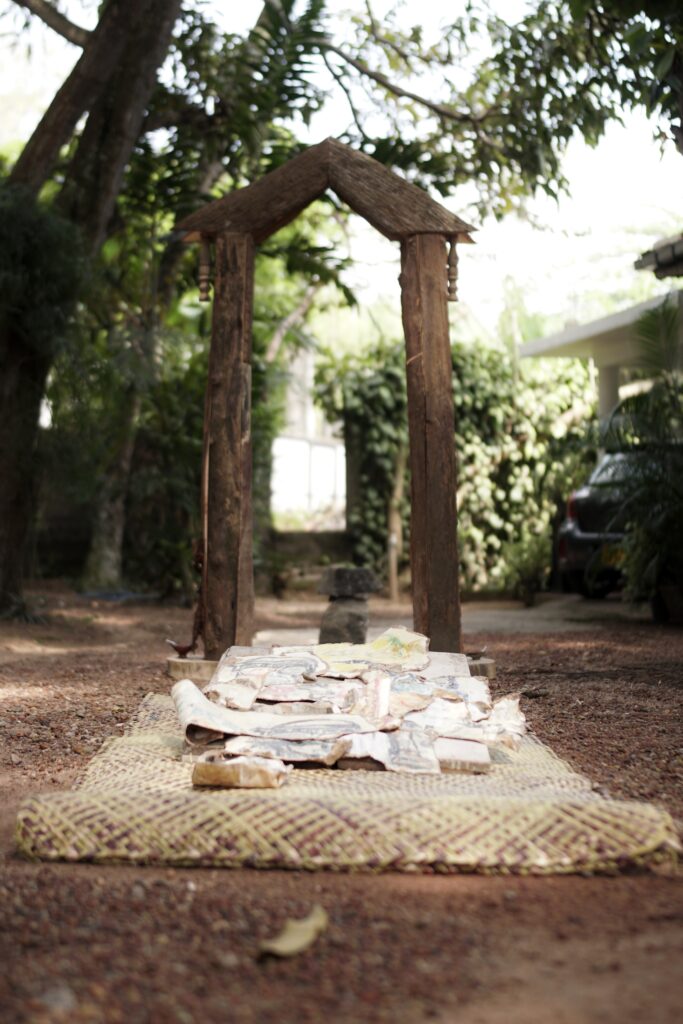
Image below shows the attachment of a fragmented layering created from the process of silk screen printing on handmade paper. Later fragments of discarded tea paper is been sutured back onto the surface of the print. This process gives a finite form of shedding or peeling skin/derma surface.
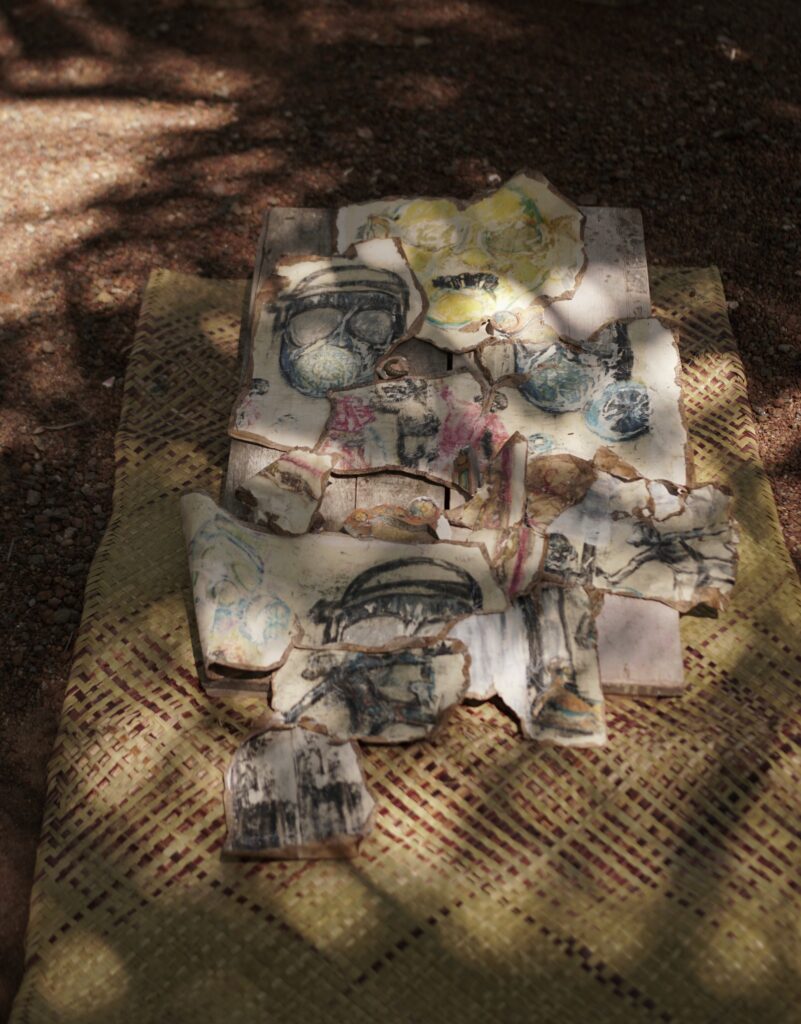
Unspoken Mothers and Remembrance
Ritualistic narrative behind the work:
Folklore narrates a ritualistic healing for for ailments for causing infertility, fetus death , young children been sick caused by the entity Black Prince, to be cured by the blessings of the deity Pattini. They will hang totems of tiny cribs or talismanic flags bearing the names of the ill ones. You may witness these hanging on the tree branches , a practice retained by both Hindu and Buddhist followers.
Mother’s who have lost their children or loved ones during the war, or others who have been still considered under the label ‘ Missing’. Hangs totems of memory , objects they have used, or images of them on the branches of these deities. These are not offerings for healing or remembrance but also calling the goddess Pattini , whose also known as Kannagi to grant justice.
Process:
Suturing fragments of cribs collected with the permission , attached onto the tendrils structures protruding from the main figurine. Floral over structure and the triangular door frame structure is created from the remains collected from the demolished heritage building known as De Soysa building( once located in Slave island, Colombo). Fragile railing is considered to more that 150 years old discarded by the construction company as the presumed it had no value.
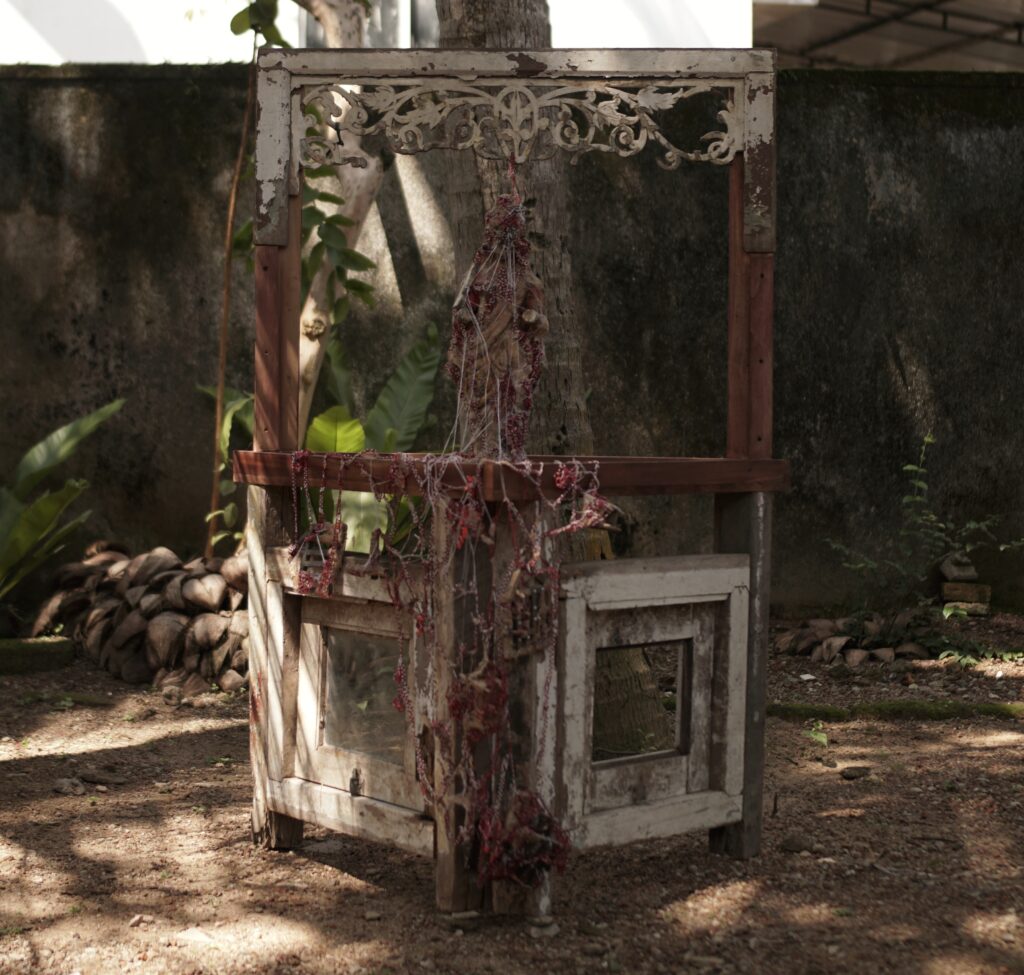
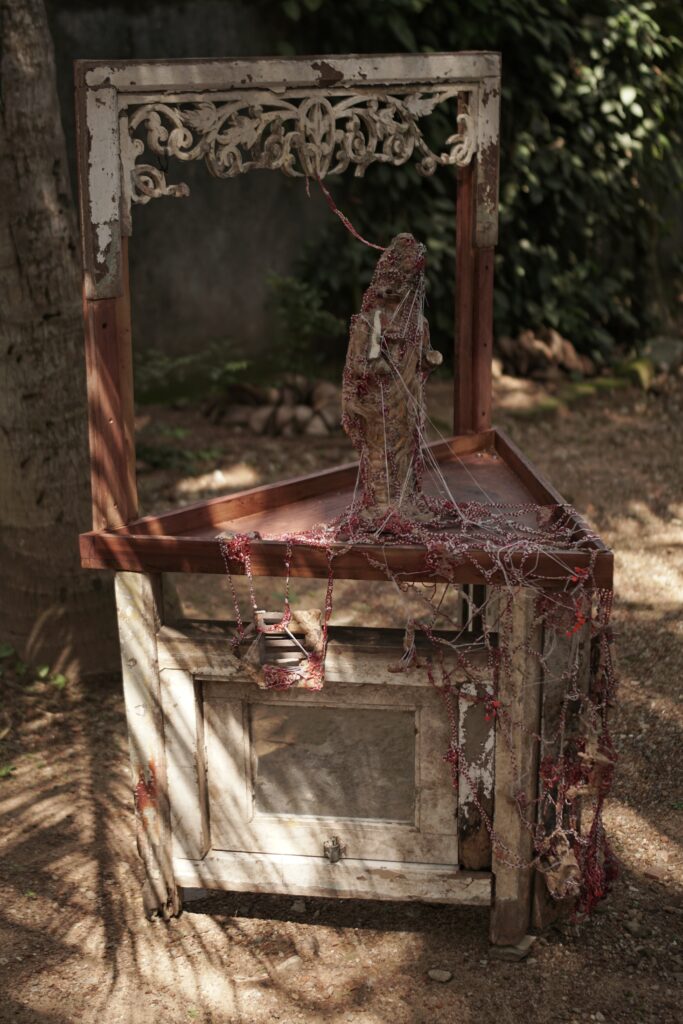
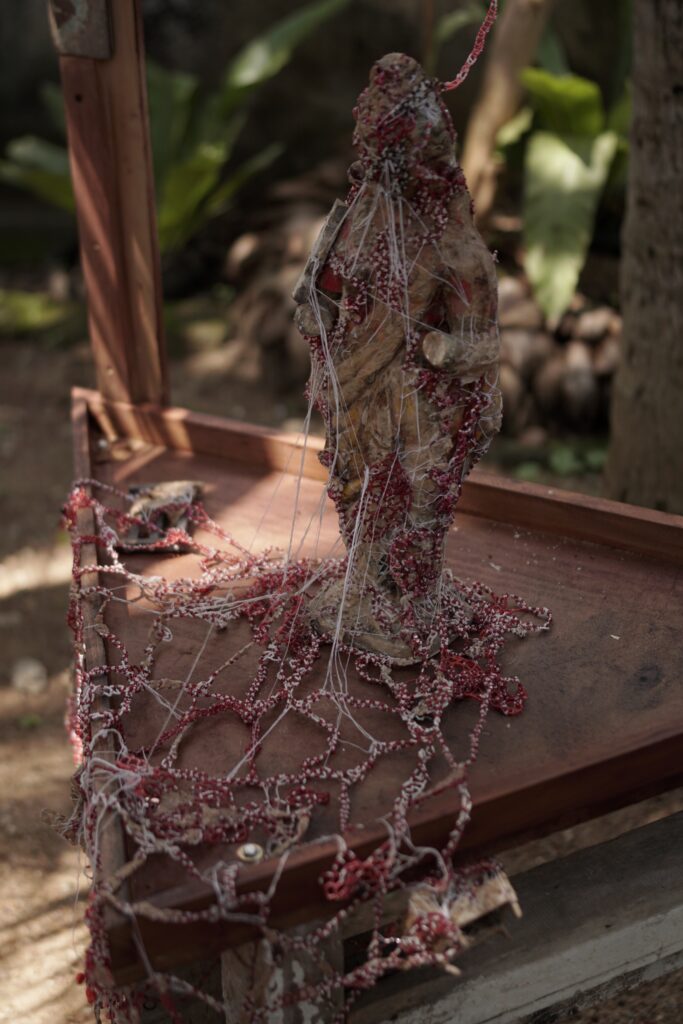

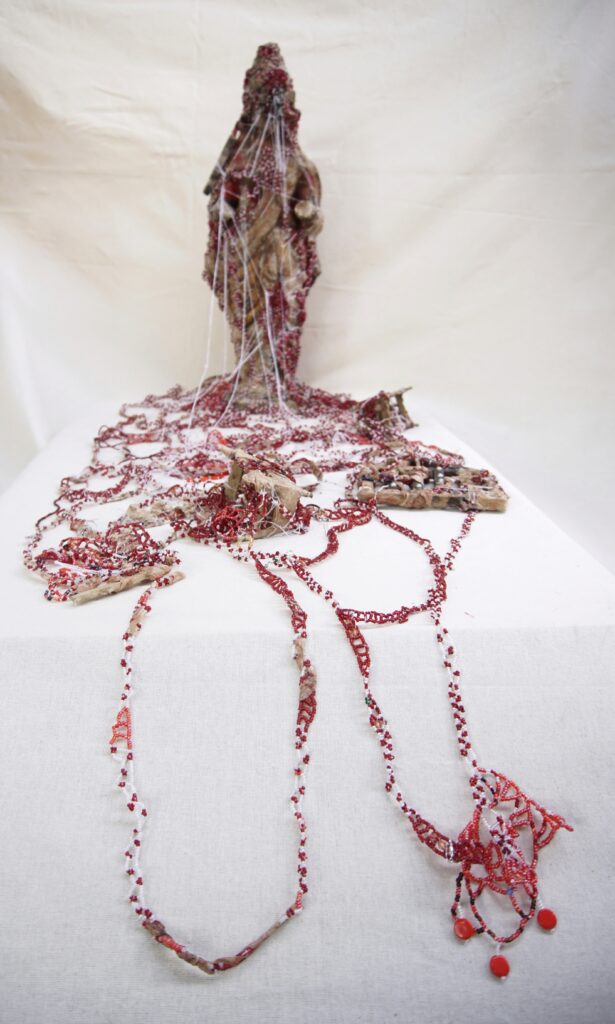
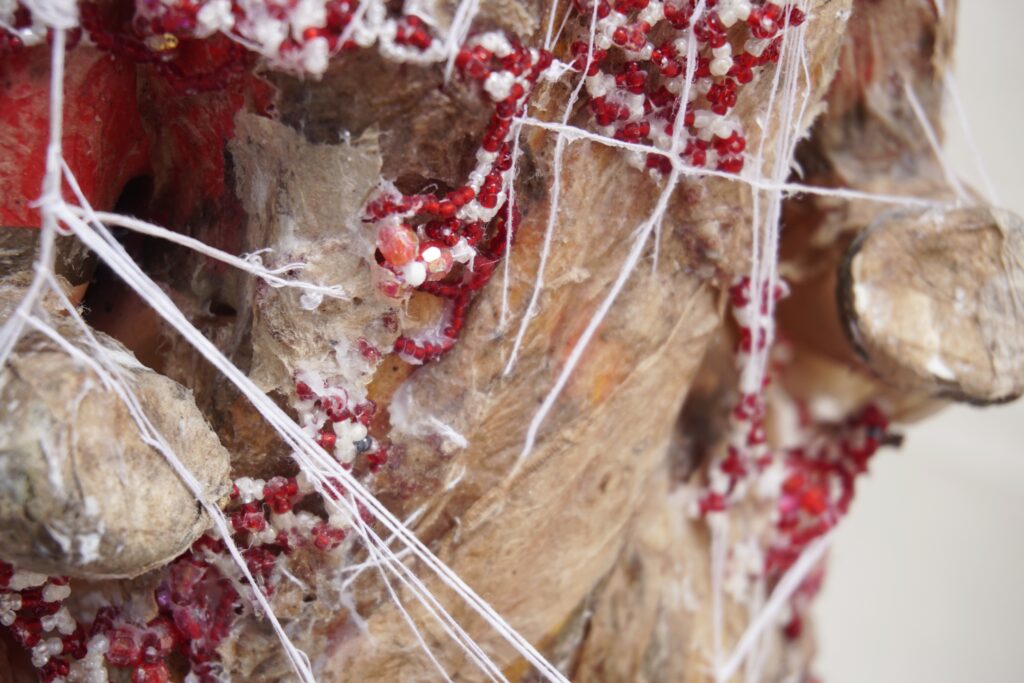
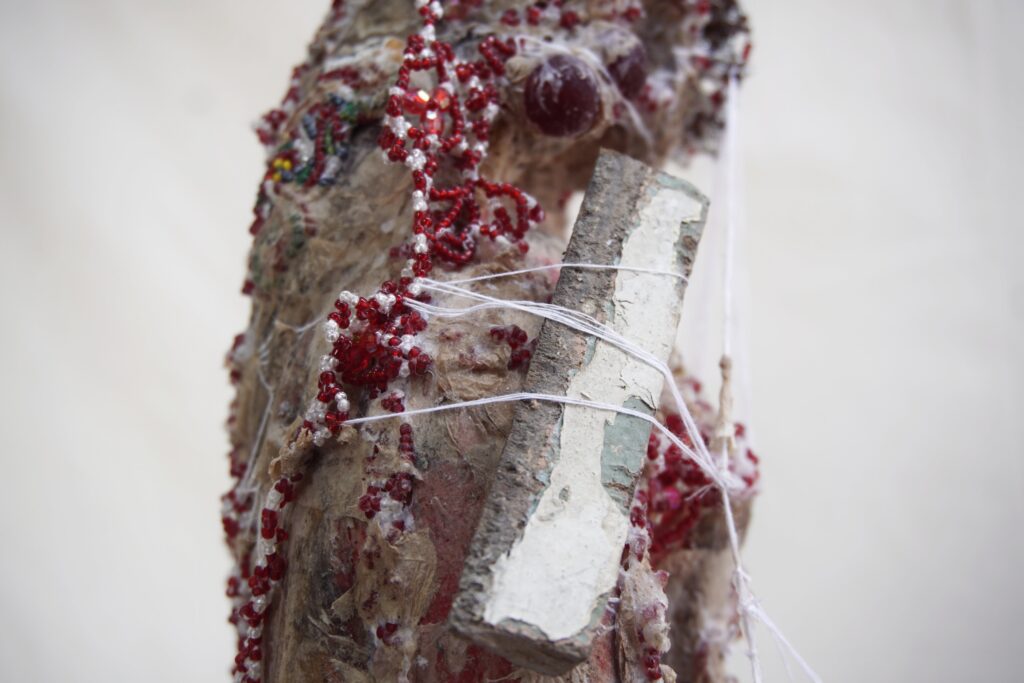
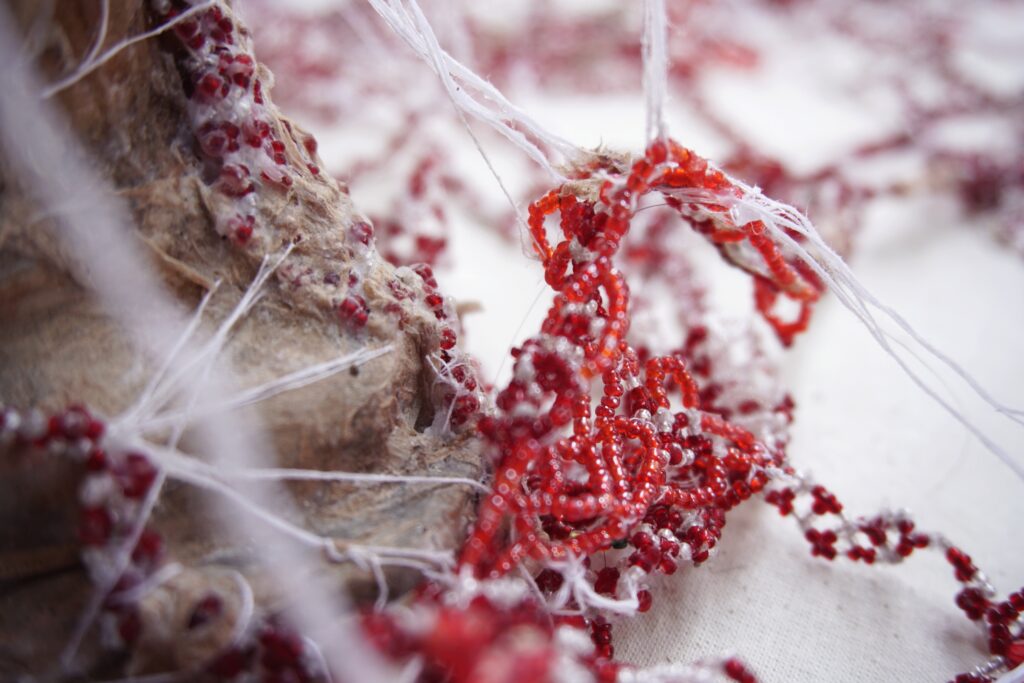
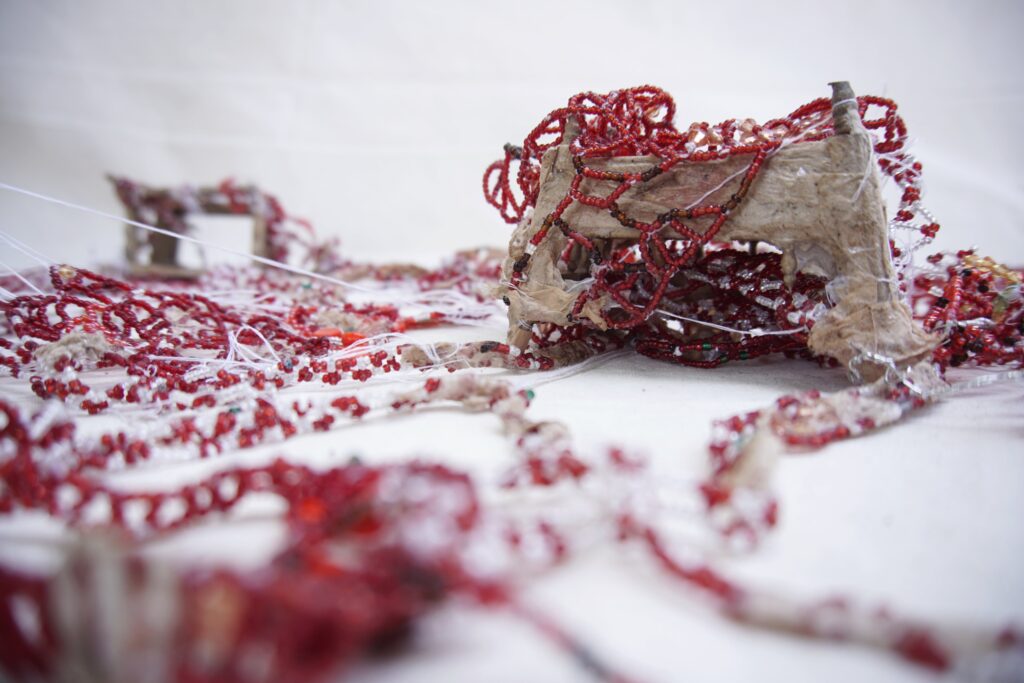
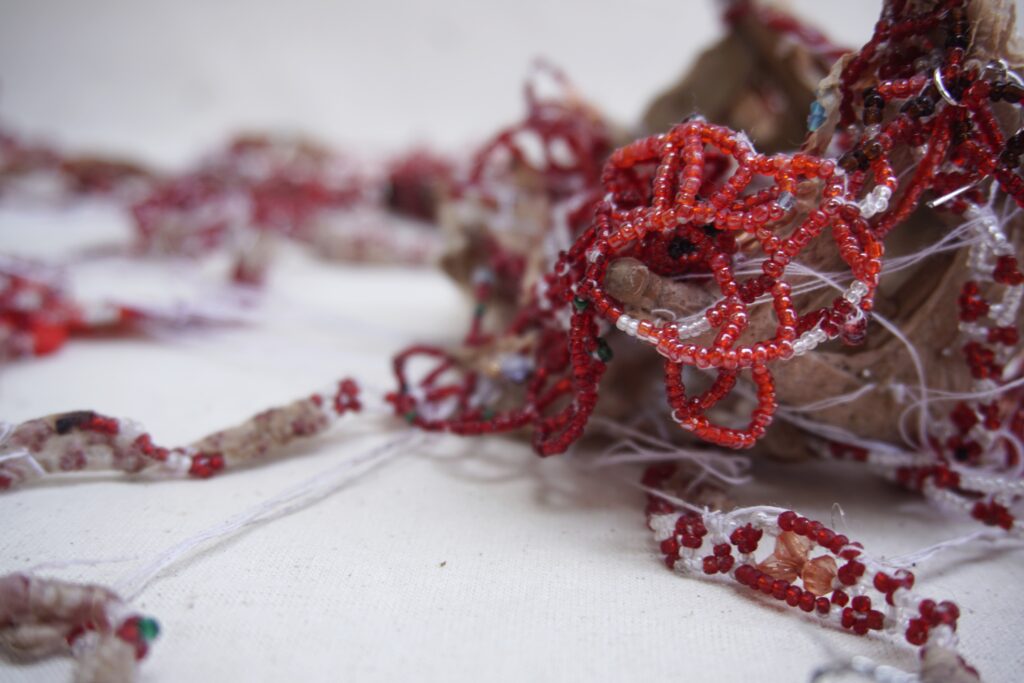
Touch and conception.
Ritualistic narrative behind the work:
During the ritual of Kalu Kumara Samayama to ward off the mishaps caused by the entity, which is combined with the Riddi Yagaya as well.
When a woman conceives a child in Bentara region. They perform a ritual of placing a clay pot aside symbolizing the conceiving. Then during the ritual, the pot is broken after giving birth or at times before birth.
Conception is obstructed by him, causing miscarriages, produce deformed children. He causes various illnesses to women from time to time.
Shells didn’t spare the womb of the pregnant woman who had her abdomen torn open in shelling. The limb of her unborn baby had protruded out through her wound.
Process:
Plaster of pari structures were demolished idols collected from the site Kochchikadde church ( post the easter sunday massacre). A cellophane covering of screen printed imagery wraps around the structure, sutured together with the intricate layers of talismanic textile patterns and discarded tea paper layering.
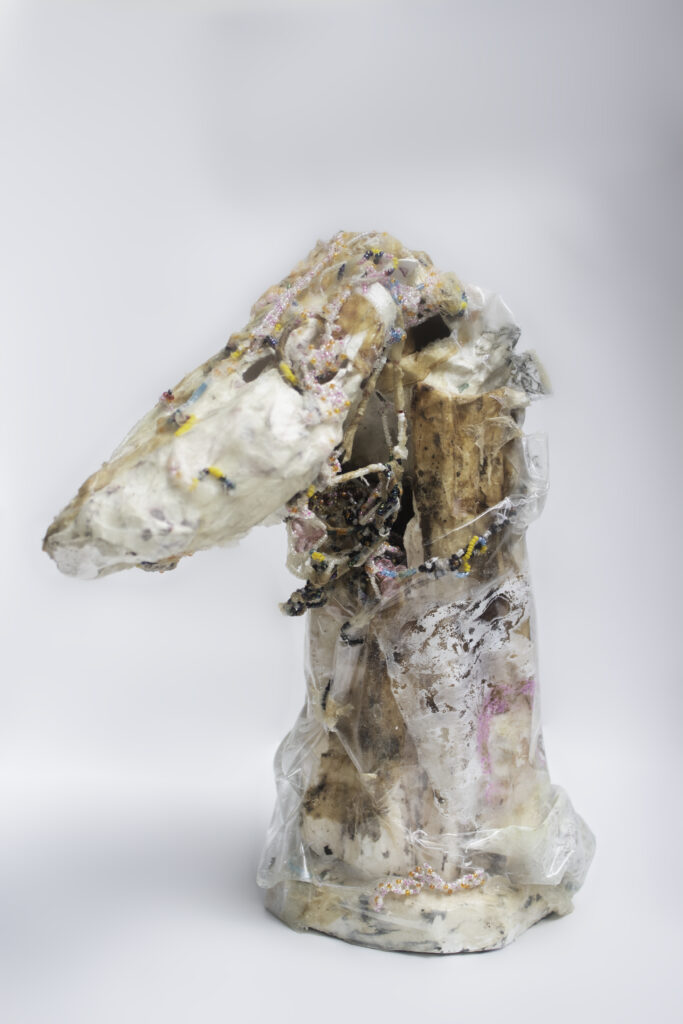
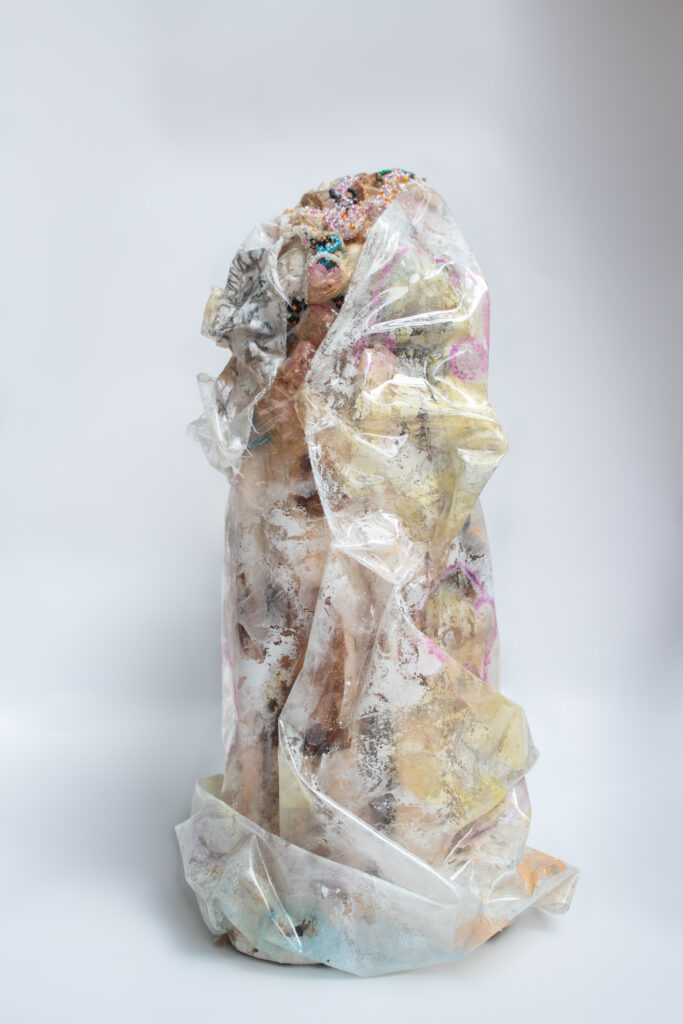
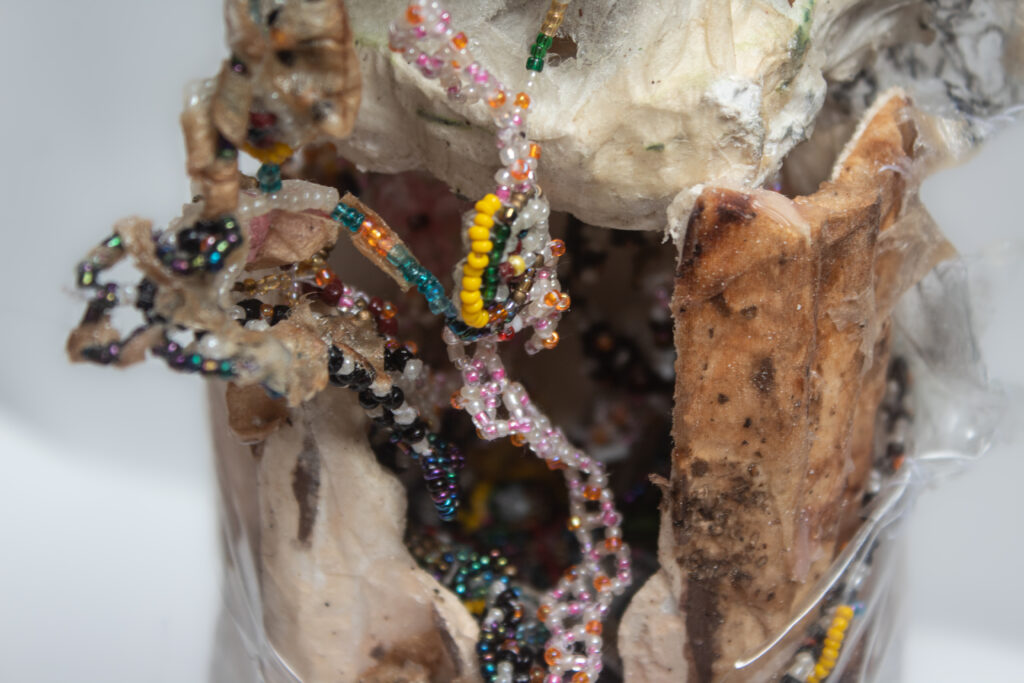
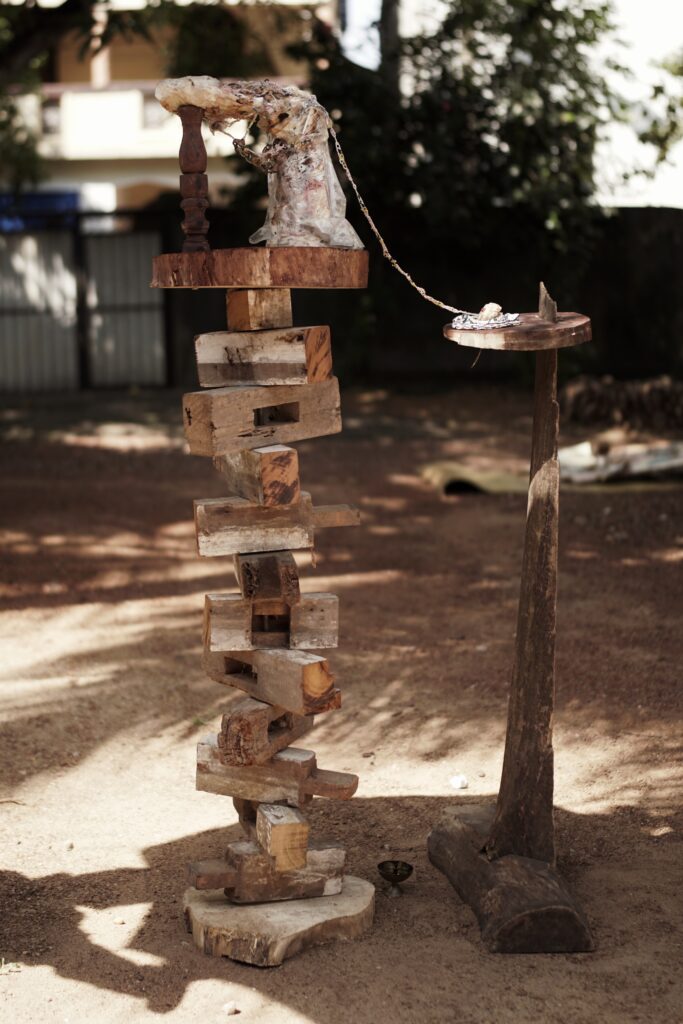
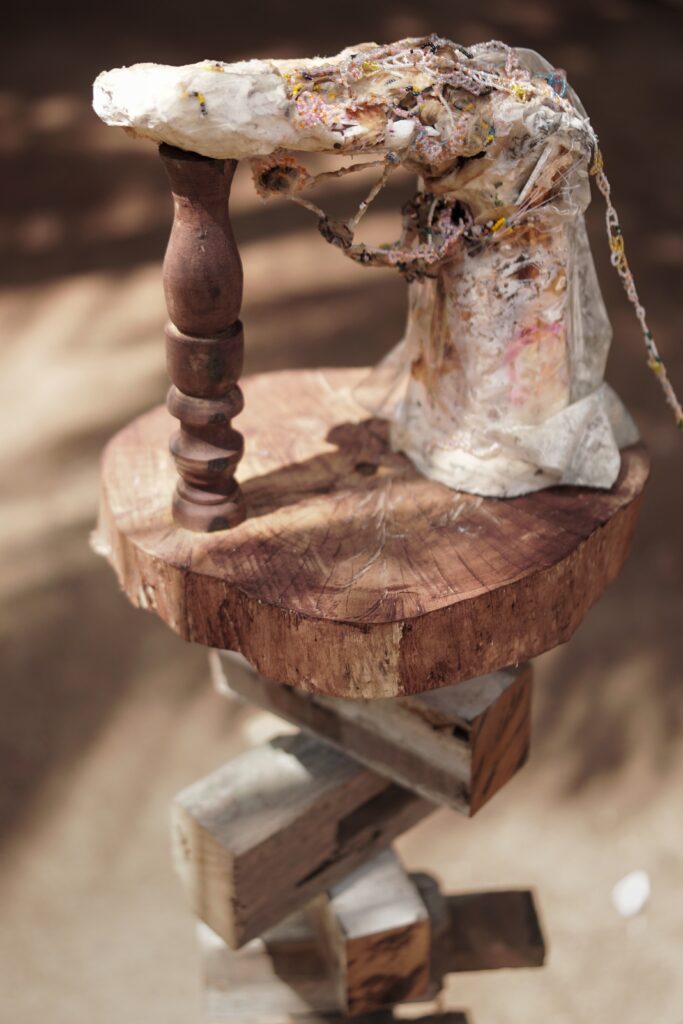
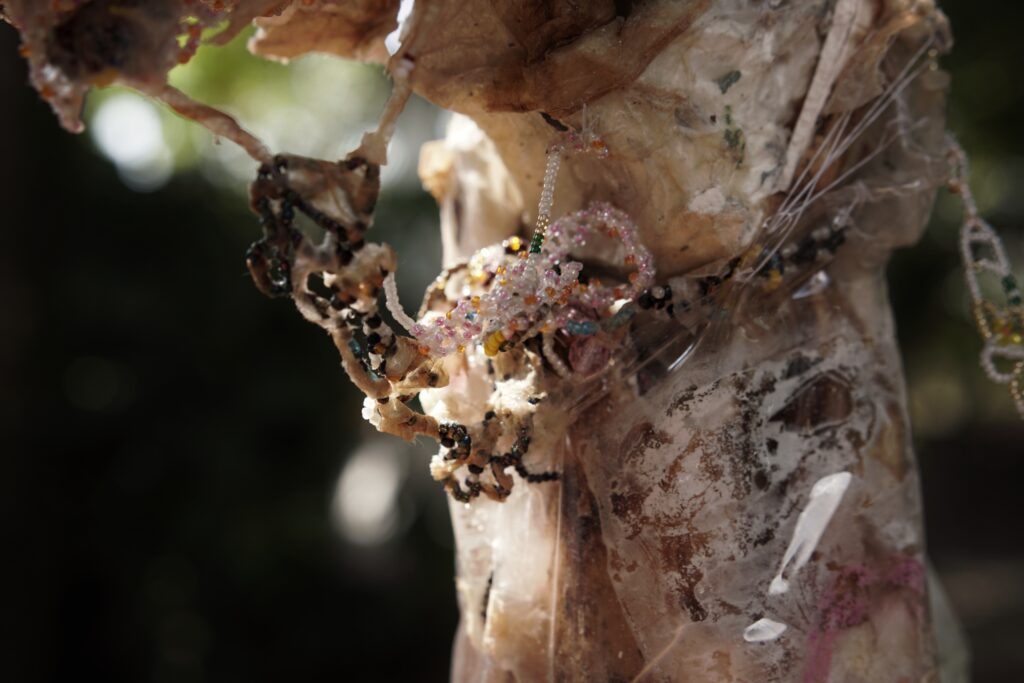
Calling to coax the beings.
Ritualistic narrative behind the work:
The imagery of a black devil with two little babies in her hands whom he will devour. Represent the deities the Ceylonese worship. Which will infuse fear perhaps grotesque of the uncivilized islander’s moral behavior.
Parents made offerings to their demon being when their children were sick or died.
“O come now, then Black female devil, who dwells under the rocks and stones of the black sea, to our offerings! Take away the sickness the host caused, by accepting our offering!”
Process :
Here the each element of bodies are been placed on a structure designed in the form of a ” Piddeni” or “offering ” structure. The upper triangular form is created from palmyra flowers collected from Northern Jaffna peninsula. There during war time the soldiers of the state believed that entities lived above these palmyra trees and one must not glance above during a holistic hour.
Wooden structure is placed on a basket form created from cane weaved mat as in a ritual. All objects are placed interweaved with each other in a form of a webbed structure.
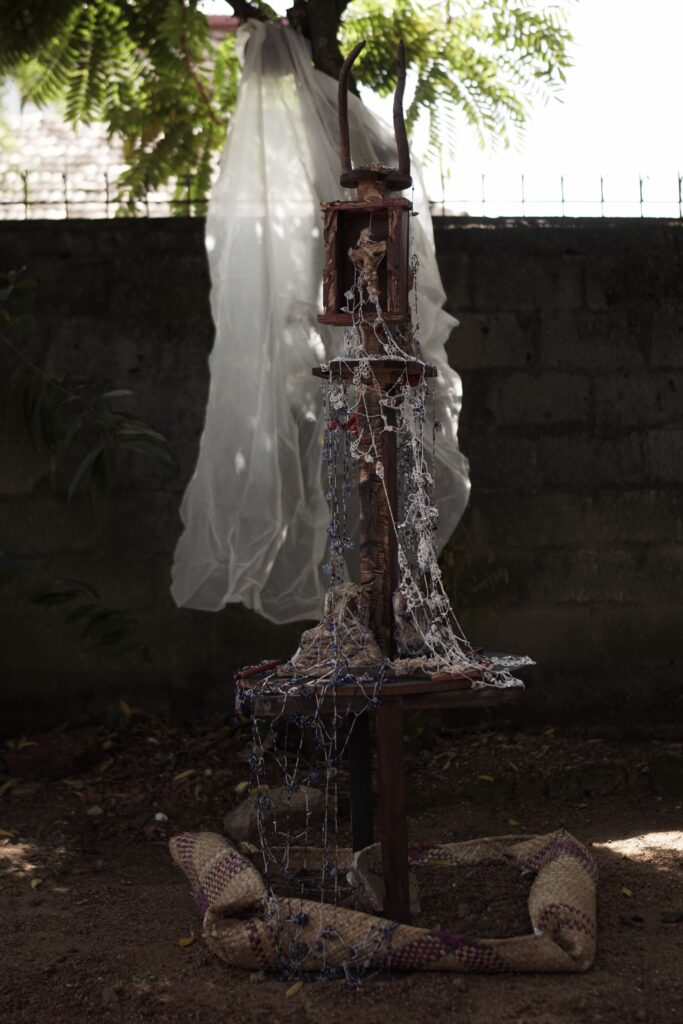
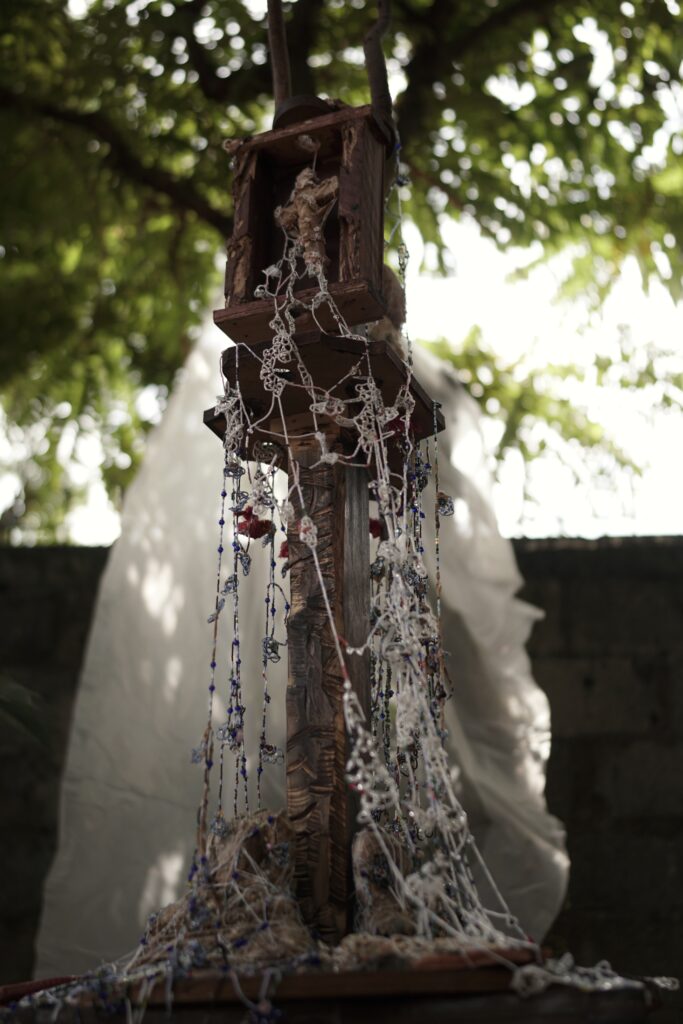
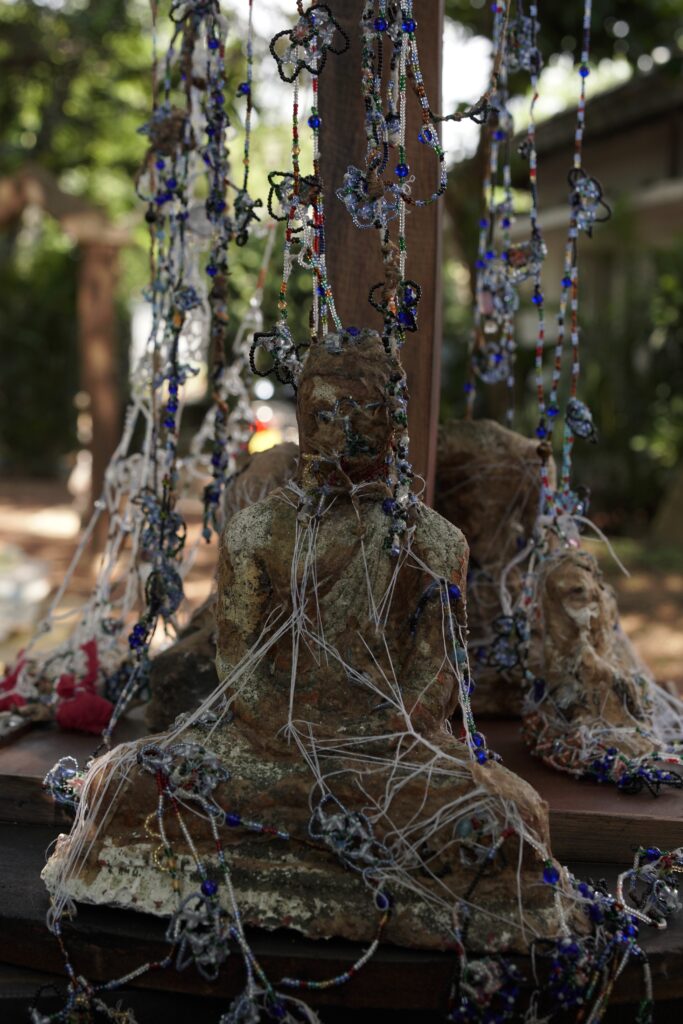
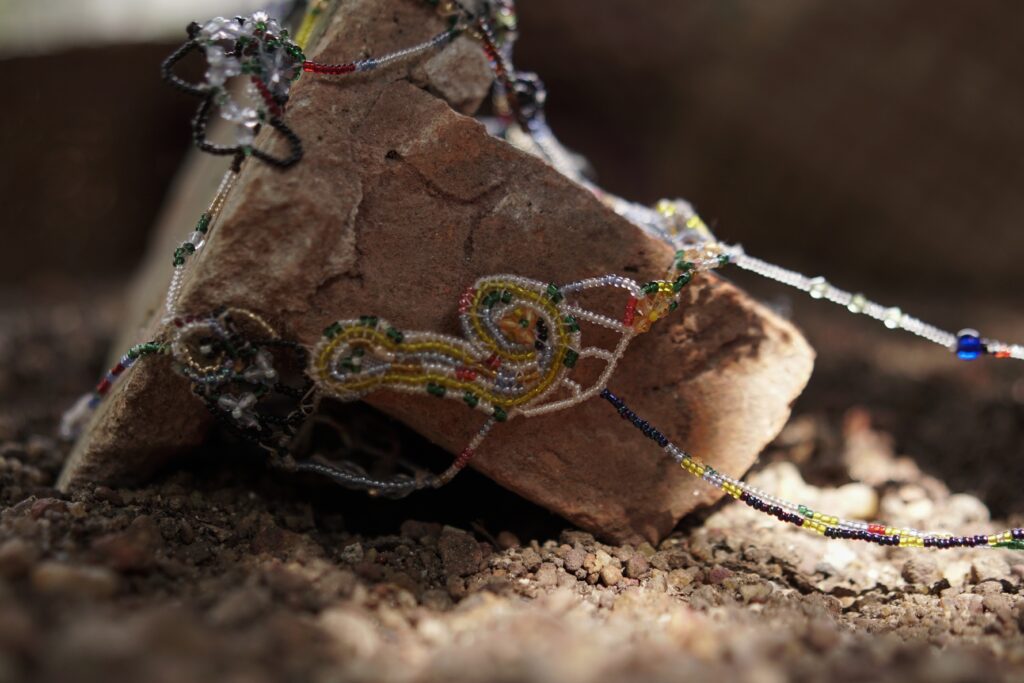
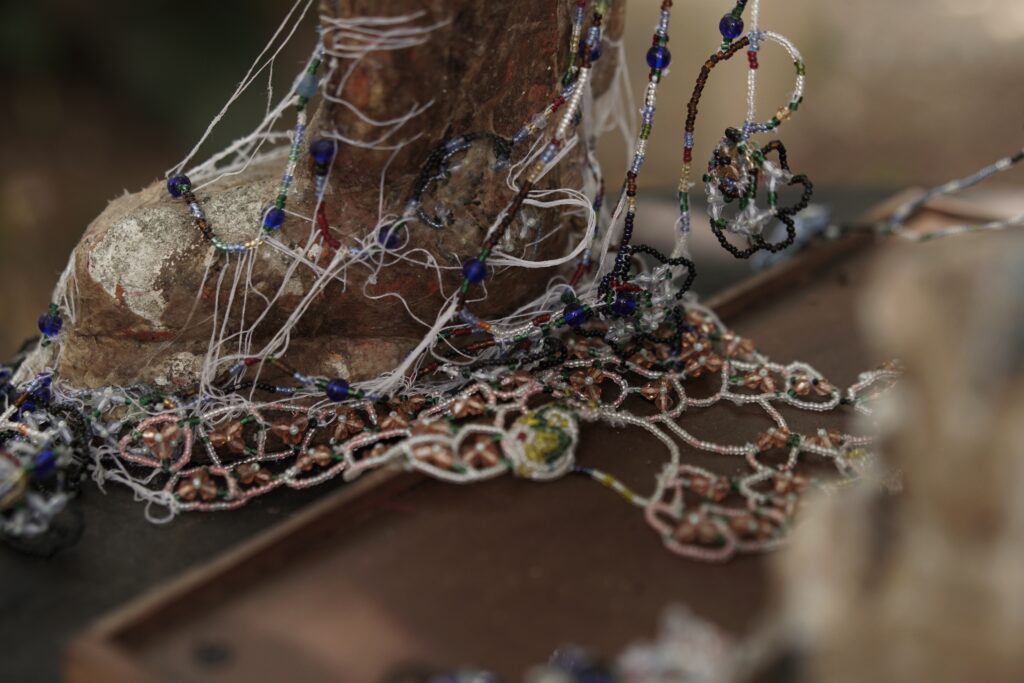
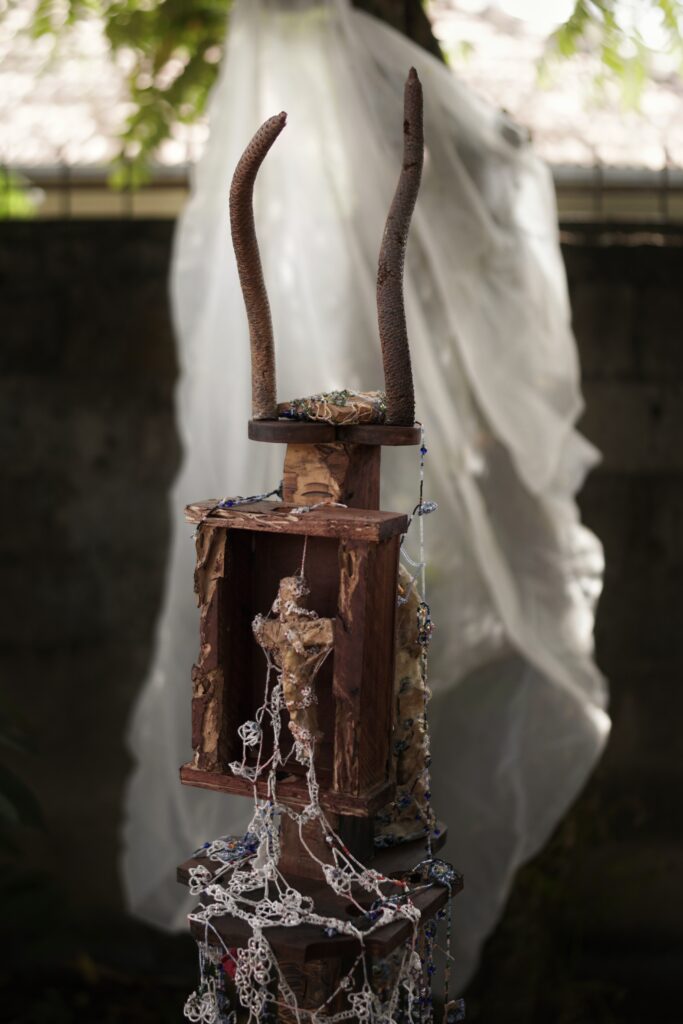
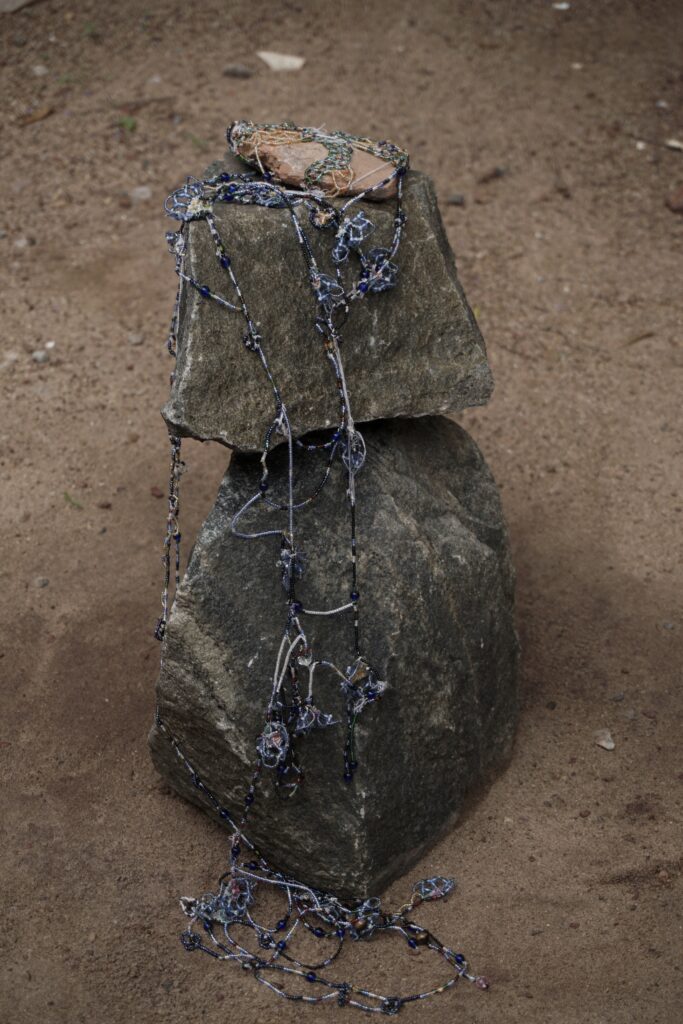
Udumbara
Ritualistic narrative behind the work:
There were people who wore nooses and ropes around who were diagnosed with incurable diseases called “Udumbara “.
They lived secluded, detached from social contact, and believed that their pure appearances have slowly faded away, mutated and disfigured. Therefore, they were “untouchables” and were named “Rogen” (disease) and “Dadi” (Stubborn). Combining these two terms creates the term Rodi, which means bodily deformity.
Process:
In the Northern region of Sri Lanka objects used in mundane livelihood converted into ritualistic objects ( e.g. fish nets used to decorate shrines) . Gasoline canon used by my mother during the 2022 economic crisis to collect her basic necessity for fuel , converts here into the form of a shrine. Expired tear gas canon used by the state resistance transforms into a sculpture kept within this shrine like structure.
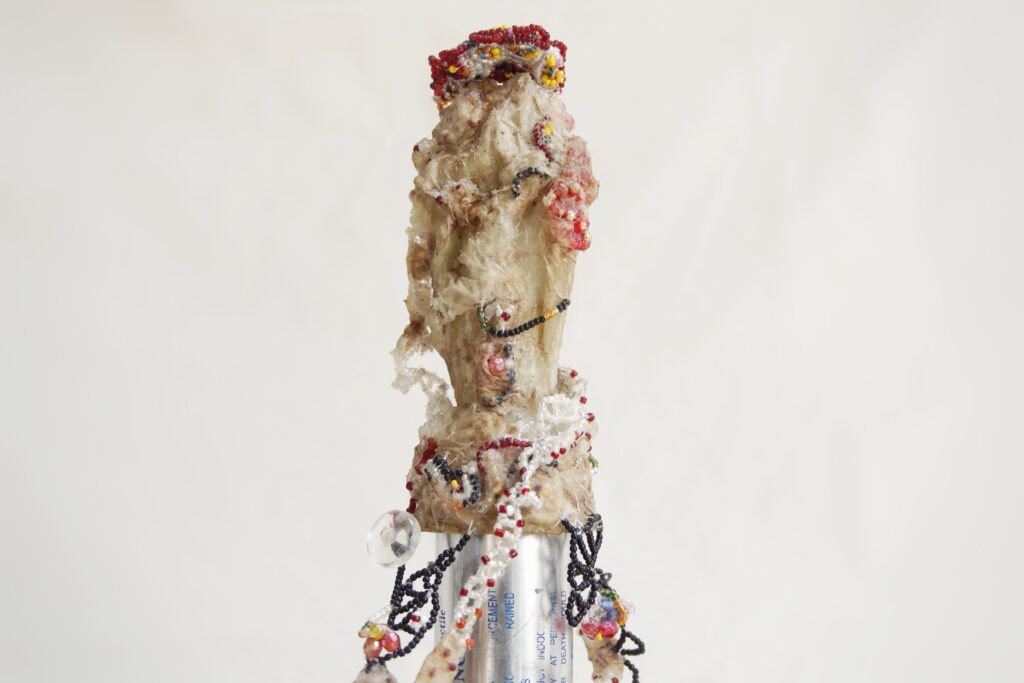
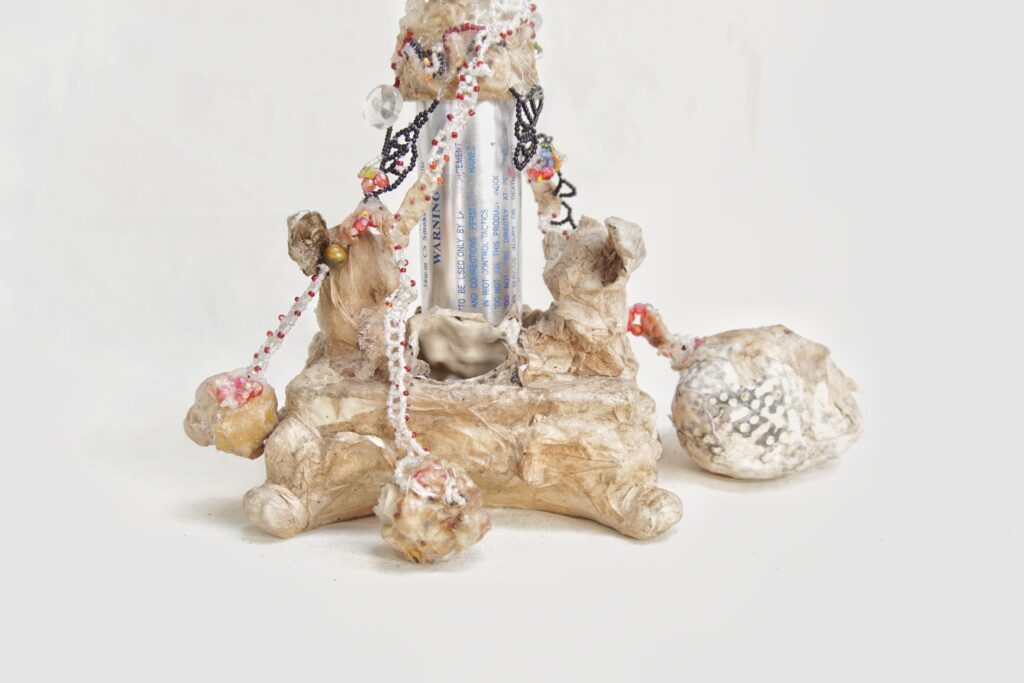
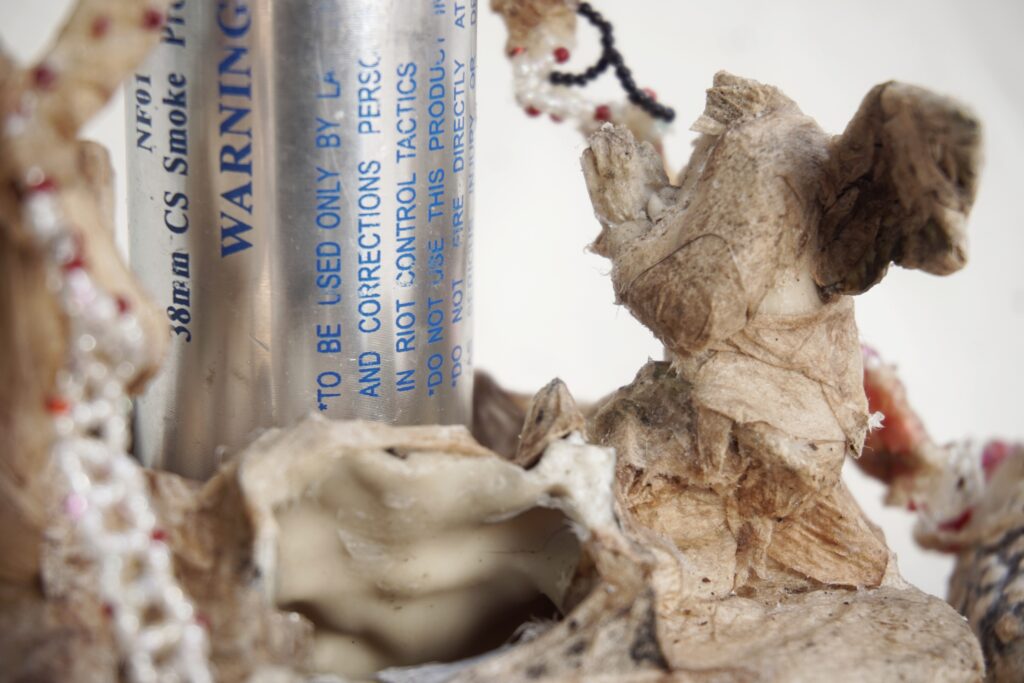
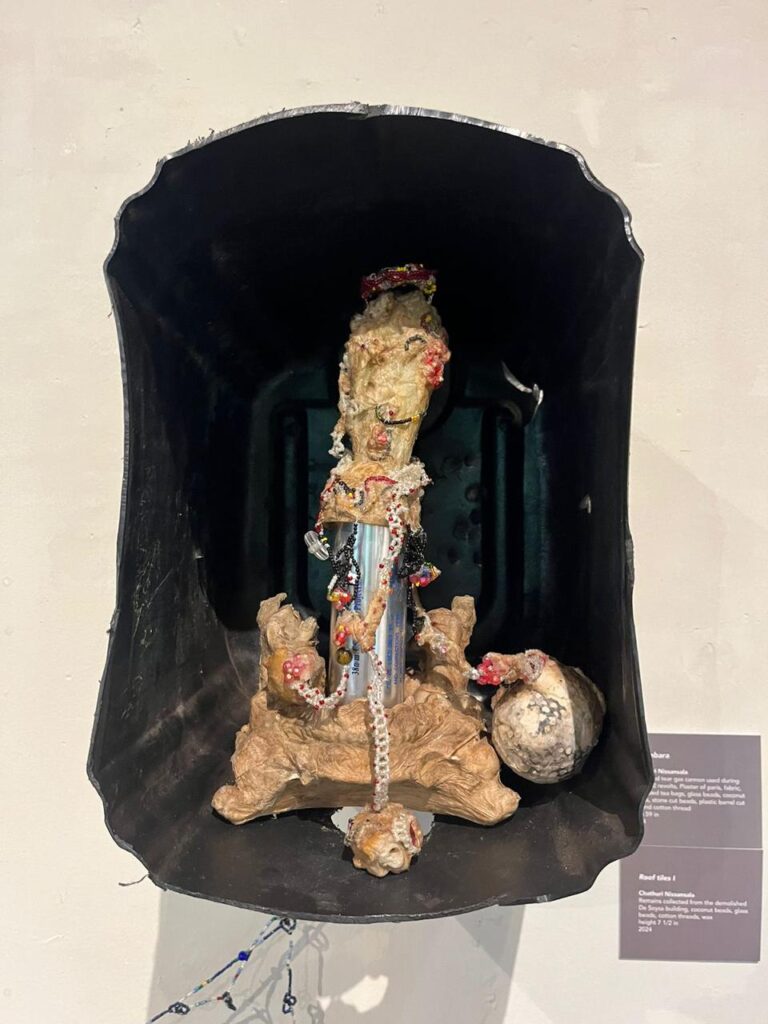
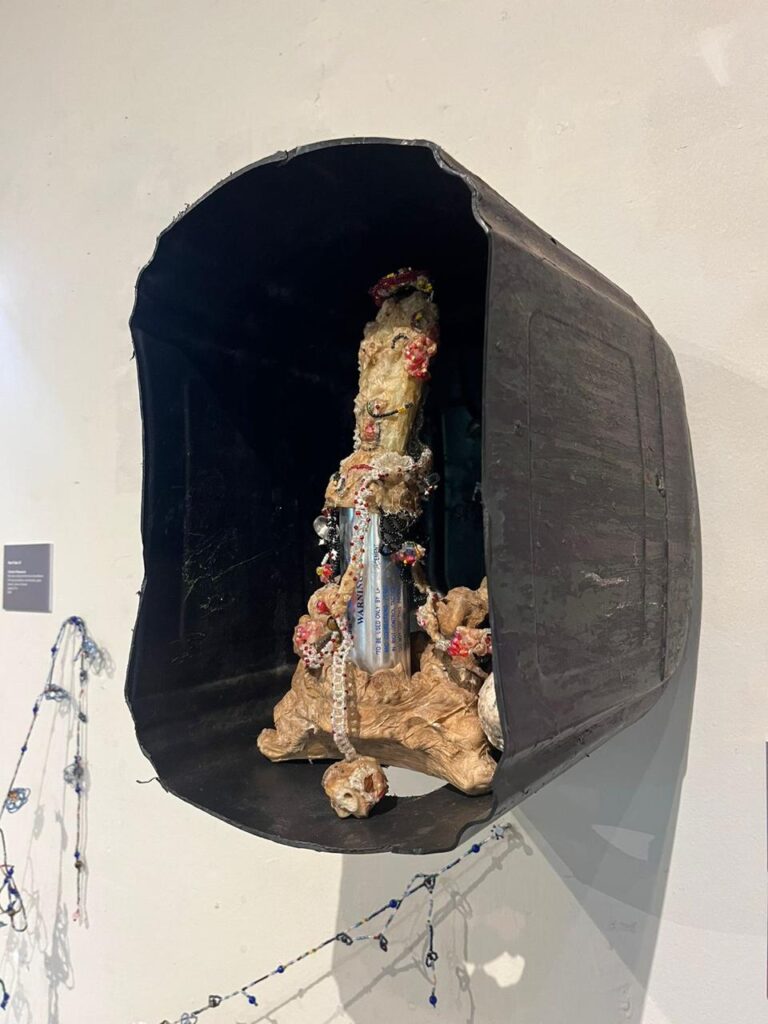
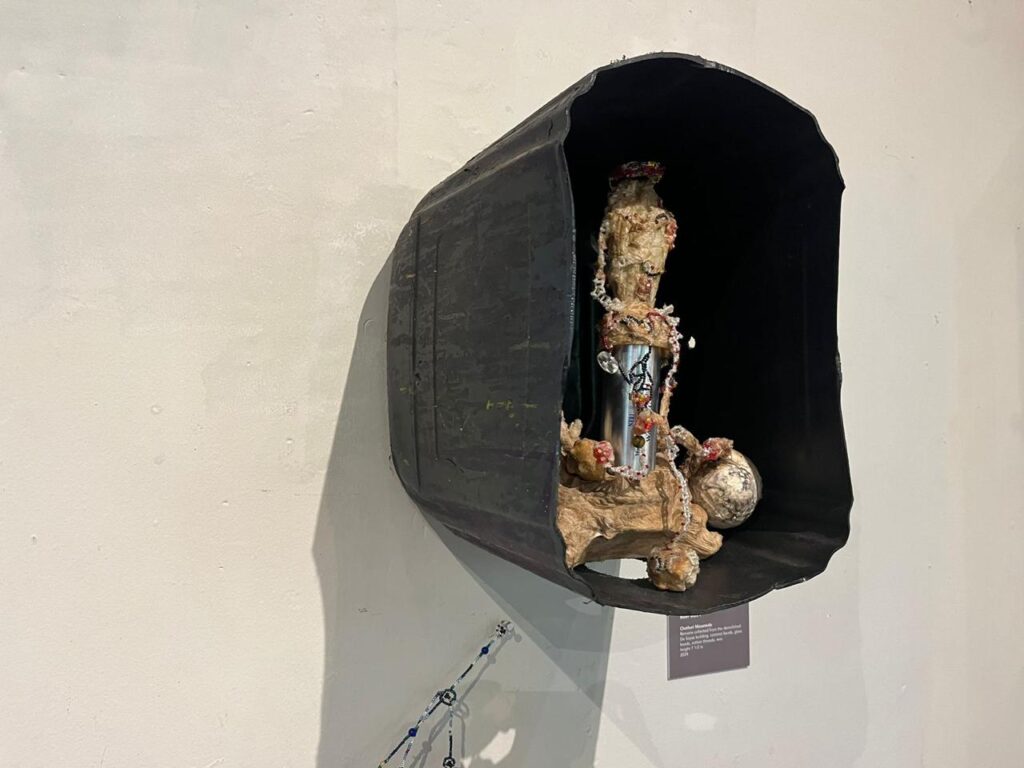
Performance : ” Nachchi Samayama”
A performance series was created within this installation space in the format of healer or “Adura” , ailed person ” Aathuraya” and the entity. Here during this performance , a collective sharing of their individual thought on belonging and what is land to queer identified person was shared within this space.
Some of the stories were shared by each individual , by wearing the mask of the character Nonchi as a form reclaiming back the possibility of the queer existence of this folk entity. ( Nonchi is a character in folk theater which is initial played by men , of old wayward mother character).
Nonchi 1
Nonchi 2
Nonchi 3
This land is not mine mother series installation : curated by Natasha Ginwala at the SNAFU premises.
